


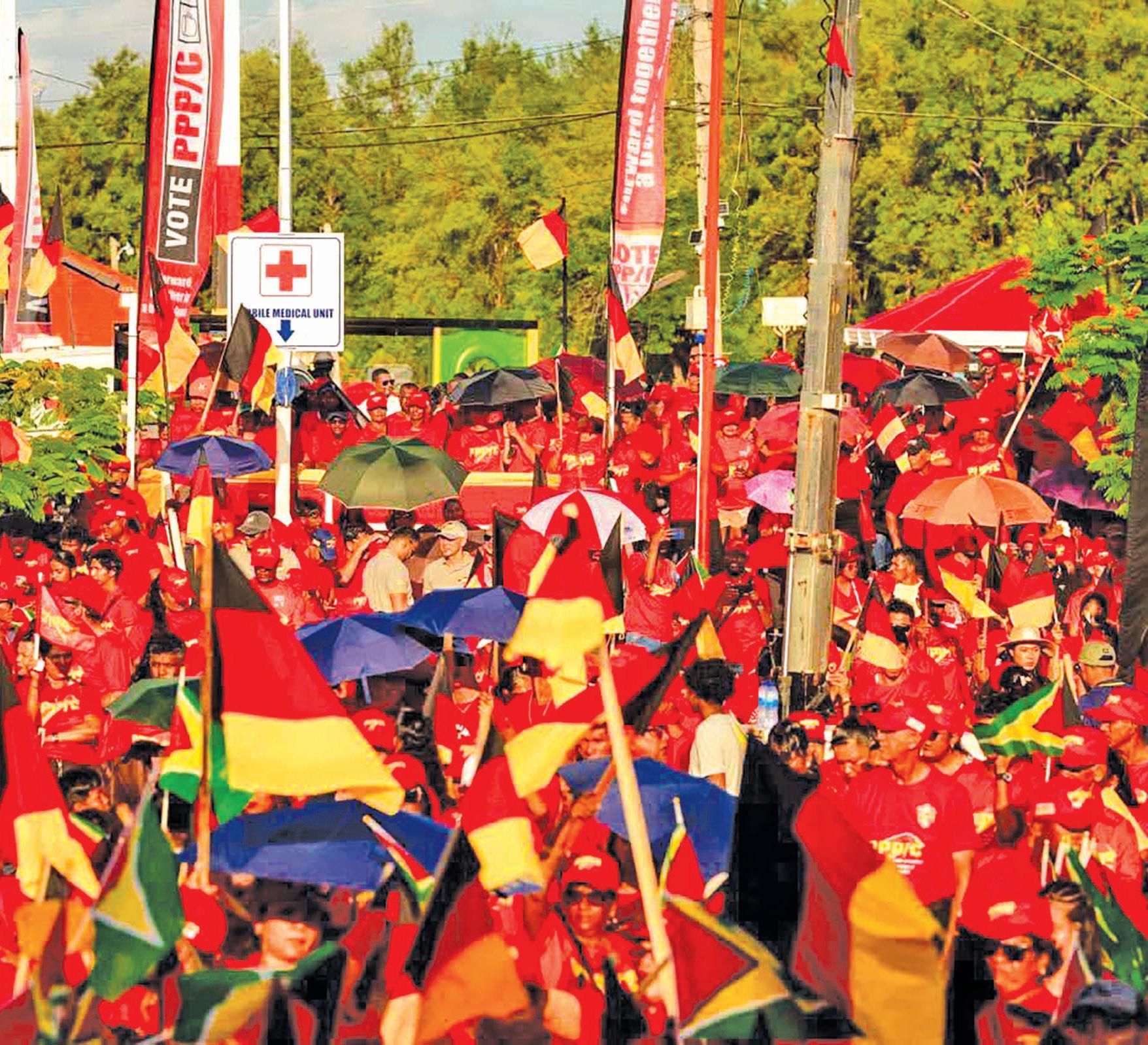
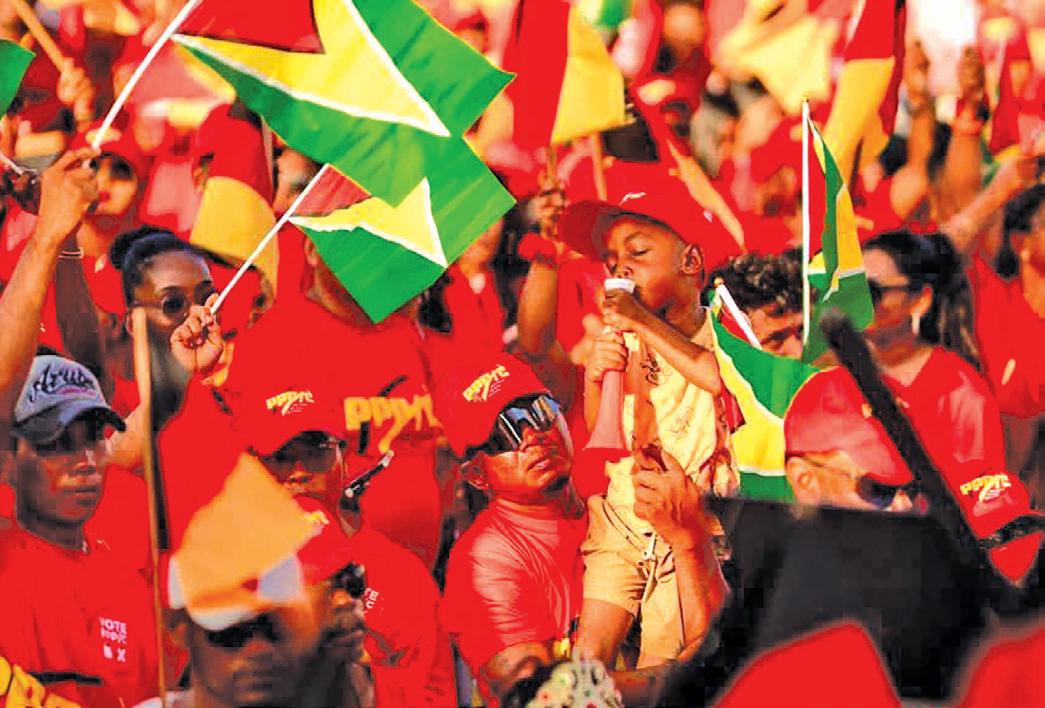
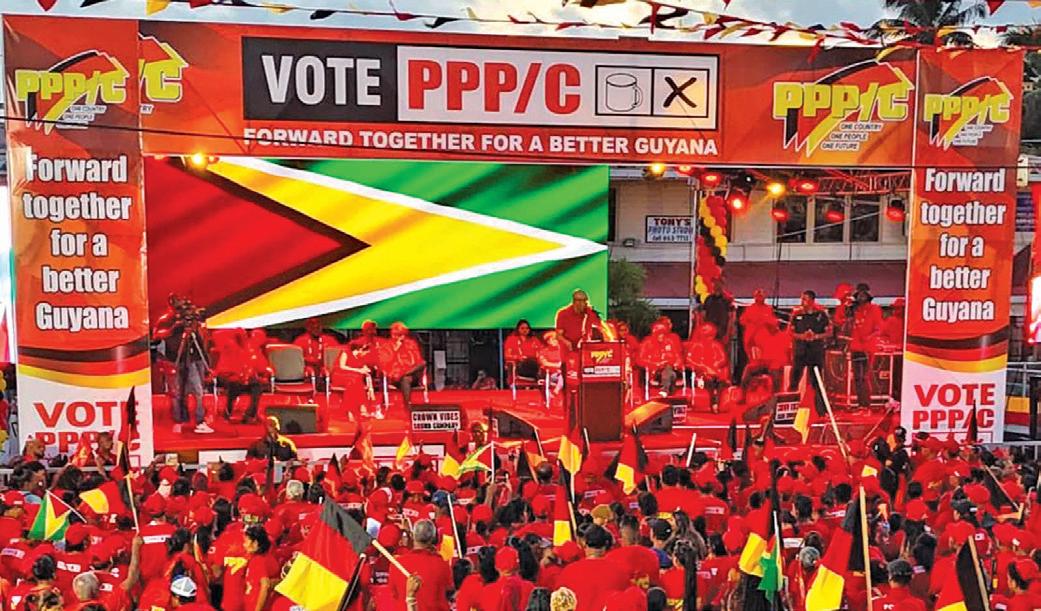
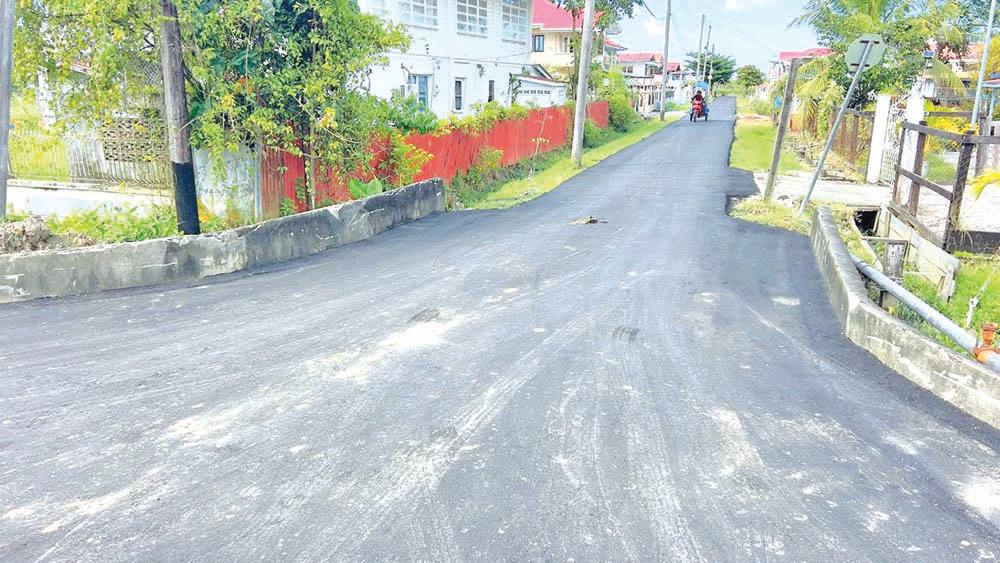
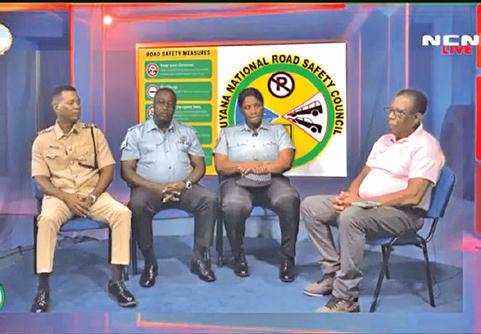
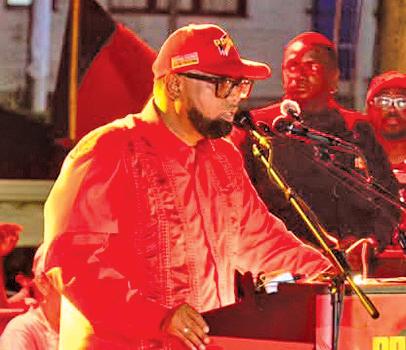
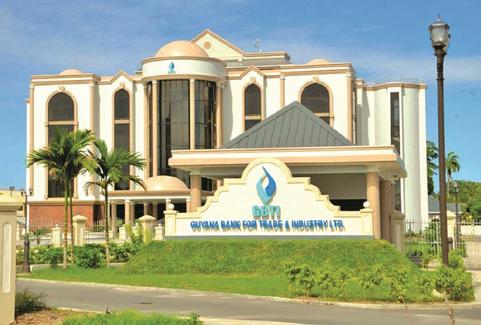
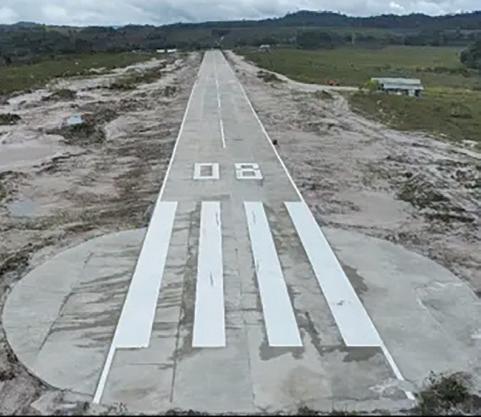
















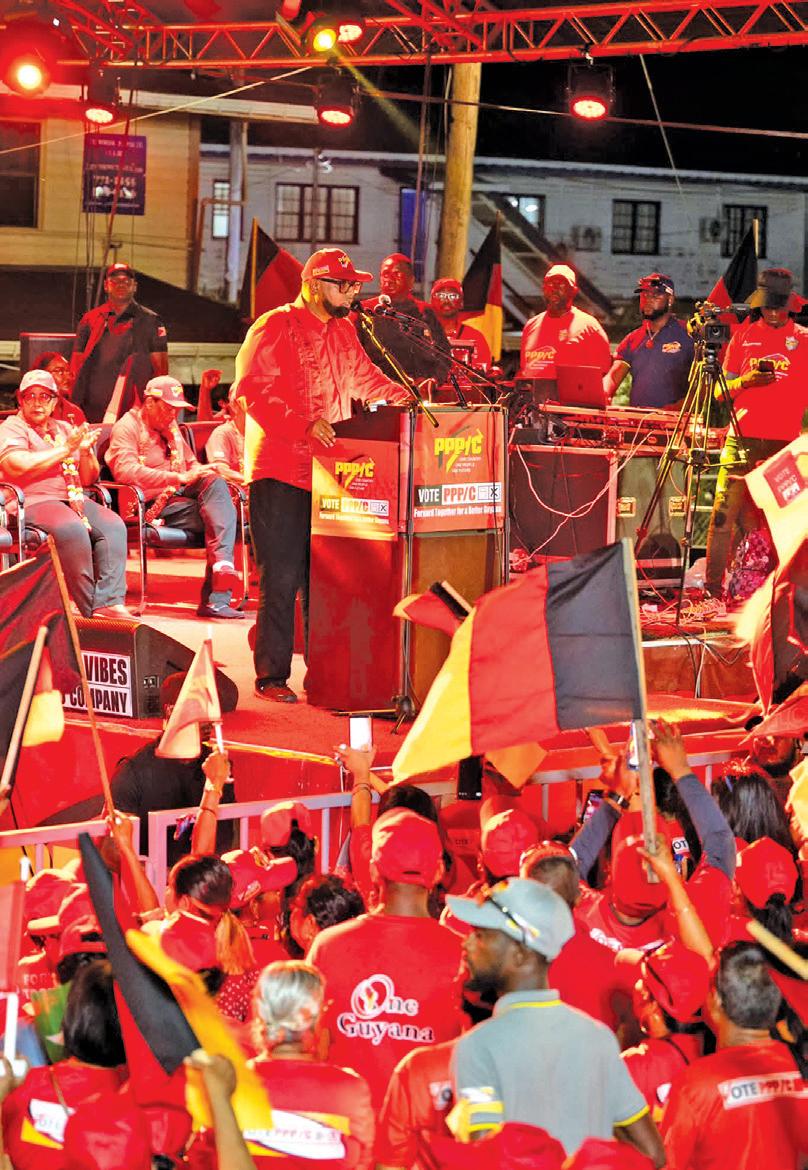
The next People’s Progressive Party/ Civic (PPP/C) Administration will implement a special tax incentive regime to spur investment in the predominantly agricultural economy of Region Two. President Dr Mohamed Irfaan Ali delivered the announcement to a packed and spirited gathering at the Anna Regina Market Square on
Saturday.
He described it as part of the PPP/C’s broader strategy to drive economic growth, create opportunities and ensure the livelihoods of residents are uplifted.
From a national stadium, the rollout of the ‘safe city’ initiative to the development of new recreational parks and community facilities, the PPP/C is demonstrating its commitment to driving more progress in the region.
“[We’re] building out the studio for our performing arts; expanding your infrastructure, investing more in D&I, building out the tourism sector and industrial hub,” he informed the crowd.
Describing Saturday’s gathering as “the largest in history”, President Ali said that Essequibo stands with the PPP/C and pledged that the party will never desert them.
He emphasised that the PPP/C Administration has laid the groundwork to move Guyana to newer heights and “now is not the time to slow down”.
The PPP/C Government will be supporting individuals “who are investing in this region, by making this region a special investment zone — a special preferential tax incentive, so that more investments will come to your region,” the President declared.
To this end, he rallied supporters to come out and ensure they cast their vote on September 1 for the PPP/C and deliver an overwhelming victory at the polls.





The Demerara Harbour Bridge will be closed to vehicular traffic on: Monday, July 28 – 03:55h-05:25h and Tuesday, July 29 –03:55h-05:25h.
The Berbice Bridge will be closed to vehicular traffic on: Monday, July 28 –06:10h-07:40h and Tuesday, July 29 – 06:50h-08:20h.


Parika and Supenaam departure times – 05:00h, 10:00h-12:00h, 16:00h, 18:30h daily.




Thundery showers are expected during the day, interrupted by sunshine during the early-morning and afternoon hours. Clear to cloudy skies, followed by thundery showers are expected at night. Temperatures are expected to range between 23 degrees Celsius and 32 degrees Celsius.
Winds: East North-Easterly to South-Easterly between 1.78 metres and 3.58 metres.
High Tide: 06:43h and 19:03 reaching maximum heights of 2.61 metres and 2.52 metres.
Low Tide: 12:40h reaching a minimum height of 0.64 metre.










Guyanese can expect to see a significant drop in the price of cooking gas with the People’s Progressive Party/ Civic (PPP/C) working on bringing down the cost as low as $1000 per cylinder. This is among the menu of measures outlined by President Dr Irfaan Ali in a Facebook live on Sunday afternoon. He said the PPP/C has a clear strategy aimed at eliminating poverty and tackling the high cost of living for all Guyanese over the next five years. Ali is returning on the PPP/C’s ticket for the upcoming September 1 General and Region Elections, seeking a re-election into office. He explained on Sunday that citizens will see massive benefits from his administration’s model Gas-toEnergy (GtE) Project, which is slated to be operationalised mid-next year. “With the gas project coming onstream, cooking gas is going to come down substantially. We are targeting a cylinder of cooking gas at $1,000… Now, that's another essential item that will reduce poverty, that will save for the household,” he posited. Currently, the retail price for a 20 lb cylinder of cooking gas ranges between $4,500 and $5,600. Located at Wales on the West Bank of Demerara (WBD), the highly-anticipated (GtE) initiative will see the construction of a 300-megawatt (MW) power plant and a Natural Gas Liquids (NGL) facility – both utilising the rich natural gas that will be piped onshore from the ExxonMobil-operated Liza Field in the offshore Stabroek Block. The PPP/C Government anticipates that the gas production will initially reach 50 million cubic feet per day, delivering at least 5,000 barrels of NGLs per day. The liquids will then be separated via the gas processing plant, for sale as cooking gas locally as well as to supply dry gas to the power plant.
A second phase of the project would see another 75 million cubic feet of gas per day being produced for a second power plant and export use.
In addition to the significantly lowered cooking gas prices, the PPP/C Administration has also been touting a 50 per cent reduction in electricity costs for all category of consumers when the GtE Project comes on-stream next year, delivering clean and reliable power. “We have already said that we'll reduce the cost of electricity by 50 per cent… and remember, addressing poverty is also how we address essential services. And electricity, reducing that by half is essen-
tial service.”
“So, when you have not only accessibility and reliability, but the cost of energy coming down by half, that directly addresses poverty because this is an essential service,” Ali explained during Sunday’s live.
Already, the current PPP/C Government has removed the value-added tax (VAT) on water and electricity that was imposed by the previous A Partnership for National Unity + Alliance For Change (APNU+AFC) Administration and is also providing subsidies to the Guyana Power and Light Inc (GPL) to offset the global increase in fuel prices thus avoiding a hike in electricity bills for local consumers. According to President Ali, Guyanese can expect more similar intervention from the next PPP/C Administration to ease the burden and enhance their standard of living. Key to this, he pointed out, is creating safety nets within societies to enhance access to essential services like health, education, water, infrastructure and then build out specific measures to address different forms of vulnerabilities and create opportunities for the poor.
Addressing poverty, cost of living
“We have crafted some very specific issues in addressing poverty, in addressing cost of living – all aimed at ensuring all of our country grow in this period of economic expansion… and we have to do it in a way in which the poli-

cies and programmes do not only address the short-term challenges, but the policies and systems that we build would address holistically, the long-term challenges and create economic growth and allow a social safety net to be built around opportunities for the poor,” he stated.
To this end, the President noted that the PPP/C has defined a clear strategy to create wealth, expand the economy, create safety nets and access to essential services, including the expansion of social programmes, especially those targeting vulnerable groups, children, women, pensioners and young people.
He said this systemic approach will build on existing policies that have already made tangible impacts, and will be strengthened by new, targeted initiatives designed to improve the lives of all Guyanese. Ali added there will also be additional initiatives to support a more comprehensive housing programme, an unparalleled
healthcare system, improved access to quality education and the expansion of agricultural initiatives to strengthen food security and empower rural communities. The President was clear that taxes will be further reduced, salaries increased, cash grants bolstered and overall development skyrocketing.
He posited during Sunday’s live that, “…this very deliberate and clear strategy [will] support specific social welfare programme, an enhancement programme that…must not add any burden… So, it's education, it's health, it's water, it's electricity, it's cooking gas. It is community wealth. It is home ownership. It is job creation, expanding the part time job programme. It is expanding the income source for household. It is increasing disposable income in the pockets of families. It is support to our pensioners… That is how we are improving quality of life. That is how we are reducing costs.”



Editor: Tusika Martin
News Hotline: 231-8063 Editorial: 231-0544, 223-7230, 223-7231, 225-7761
Marketing: 231-8064Accounts: 225-6707
Mailing address: Queens Atlantic Industrial Estate Industrial Site, Ruimveldt, Georgetown
Email: news@guyanatimesgy.com, marketing@guyanatimesgy.com
The decision by Opposition Leader Aubrey Norton to not respond to President Irfaan Ali’s communication requesting his agreement to the appointment of a substantive Chancellor of the Judiciary and a Chief Justice is most unfortunate. Art 127 of the Constitution stipulates, “The Chancellor and the Chief Justice shall each be appointed by the President, acting after obtaining the agreement of the Leader of the Opposition.” This was intended to secure bipartisan support for these two apex judicial positions since under our governmental system, the Judiciary is the arbiter of the Constitution, which demarcates the powers of the Executive and legislative branches of Government.
Guyana has not had a confirmed Chancellor for two decades – since Justice Désirée Bernard vacated the position in 2005 when elevated to the Caribbean Court of Justice (CCJ) Bench. She was succeeded by Justice Carl Singh, but bereft of the agreement by Opposition Leader Robert Corbin, he functioned as Acting Chancellor for 12 years until he retired in May 2017. He was succeeded by then acting Chief Justice Yonette Cummings-Edwards, as Acting Chancellor because no agreement could be reached between then President Granger and Opposition Leader Bharrat Jagdeo. It would appear that Justice Yonette Cummings-Edwards was simply a placeholder, since it was reported that President Granger had already approached sitting Belizean Chief Justice Kenneth Benjamin for the position as early as January 2017. Benjamin was a Guyanese who had been associated with the GDF while Granger had been a Brigadier.
As for the Chief Justice’s position, Justice Yonette Cummings-Edwards had acted in that capacity from December 2015 to May 2017 when she was appointed acting Chancellor. She has now proceeded on leave prior to retirement. Justice Roxane George, SC, had been appointed to succeed CummingsEdwards in 2017 as Acting Chief Justice and has now been nominated by President Ali for the Chancellor of the Judiciary’s position. What this means is the status quo of not having a substantive Chancellor for two decades and a Chief Justice for one decade will continue.
This state of affairs had been trenchantly criticised by the now immediate past President of the CCJ, Justice Adrian Saunders when he addressed the Guyana Bar Association in April 2022. He said, “There is one significant blot on an otherwise impressive Guyanese legal and judicial landscape. For the country to have not appointed a Chancellor for 17 long years is very disappointing; likewise, to be without an appointed Chief Justice for several years. As the President of your final court, I believe I have a right and a duty publicly to express the view that Guyana should not let this year pass and not remedy this regrettable situation.” On stepping down from our Apex Appellate Court earlier this year, Justice Saunders reiterated that he found the unchanged situation “most regrettable”.
A month after Justice Saunders’ very pointed 2022 criticism, newly-elected Opposition Leader Norton had communicated to President Ali that he would agree to Justices Cummings-Edwards and George being confirmed substantively as Chancellor and Chief Justice respectively. President Ali demurred, but with Justice Cummings-Edwards now stepping down and he has now nominated Justice George – who evidently has the Opposition Leader’s confidence – it is somewhat anomalous that he has now rebuffed her. Pres Ali has selected Justice of Appeal Navindra Singh to act as Chief Justice.
We concur with Justice Saunders on the need for these appointments to become substantive, and note this is a symptom of our increasingly-divided politics which will paradoxically intensify the “judicialization of politics”. “This refers to both the expansion of Judges’ powers at the expense of politicians and executives by conferring decision-making rights to the former, and the proliferation of legal discourse, procedures, and decision-making methods outside the judicial sphere.”
One criticism of this state of affairs – which is a growing worldwide phenomenon – is that political decisions will be made by individuals not elected through a democratic process. The professionalism of the Judiciary thus becomes critical and must be safeguarded by the citizenry.
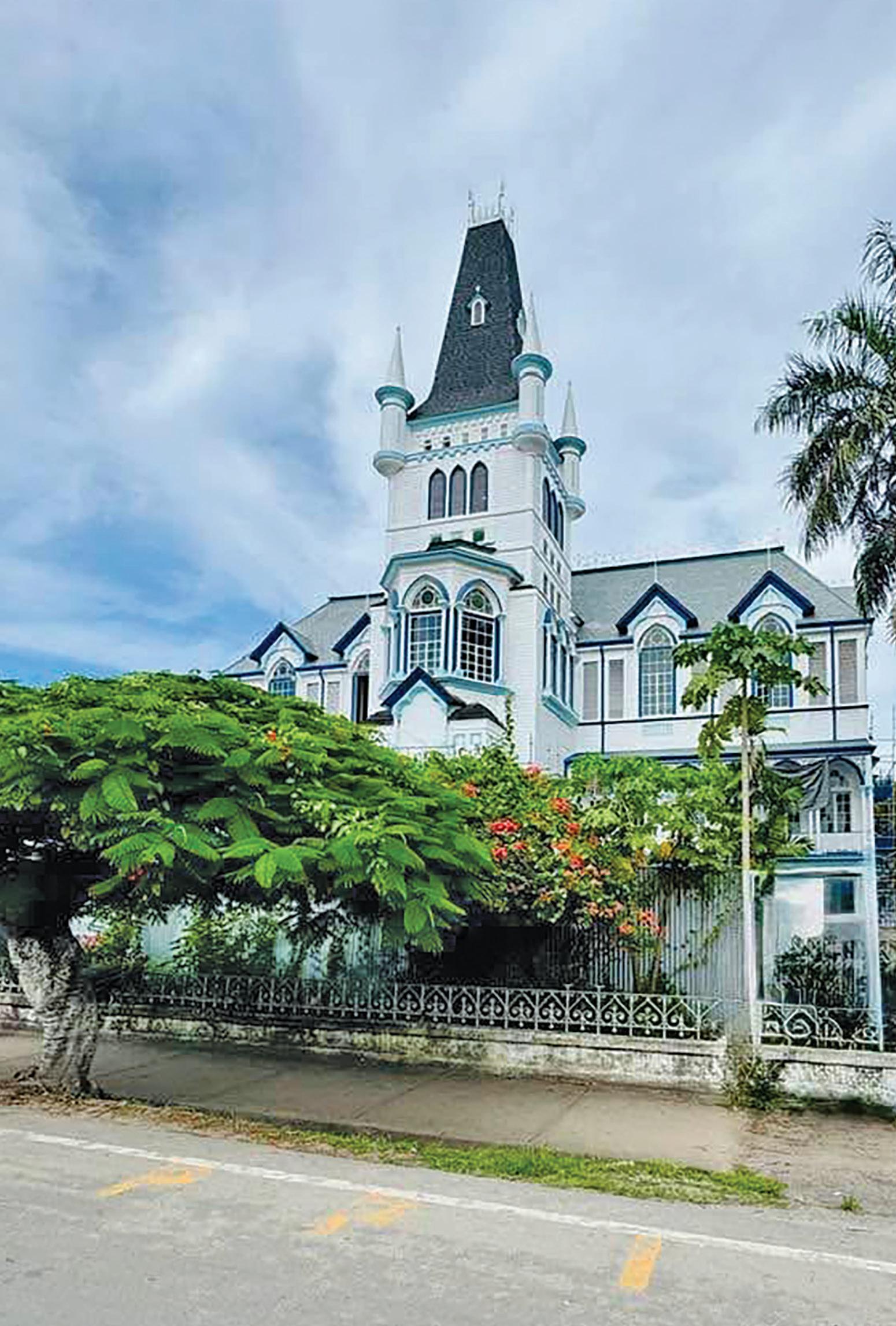
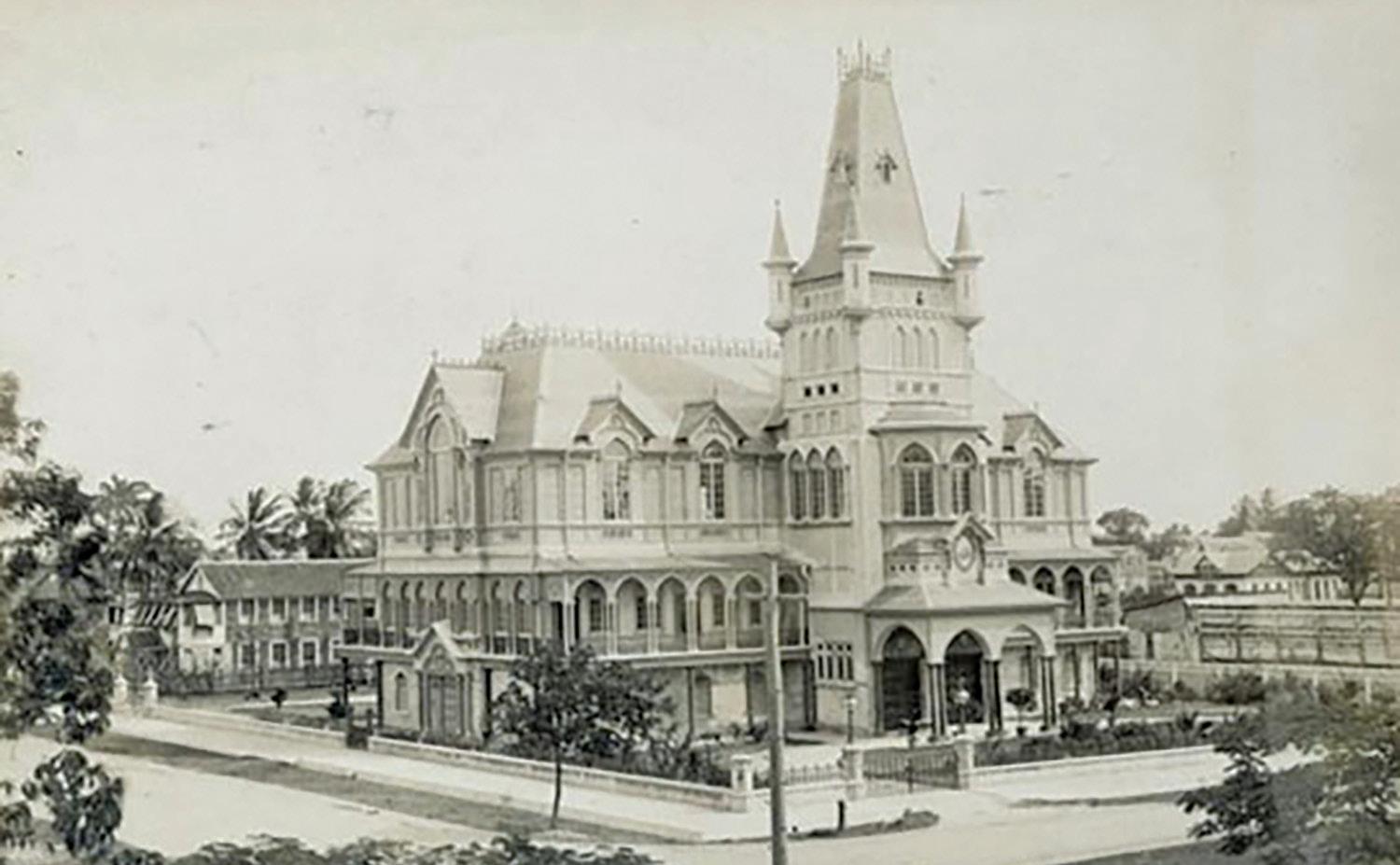
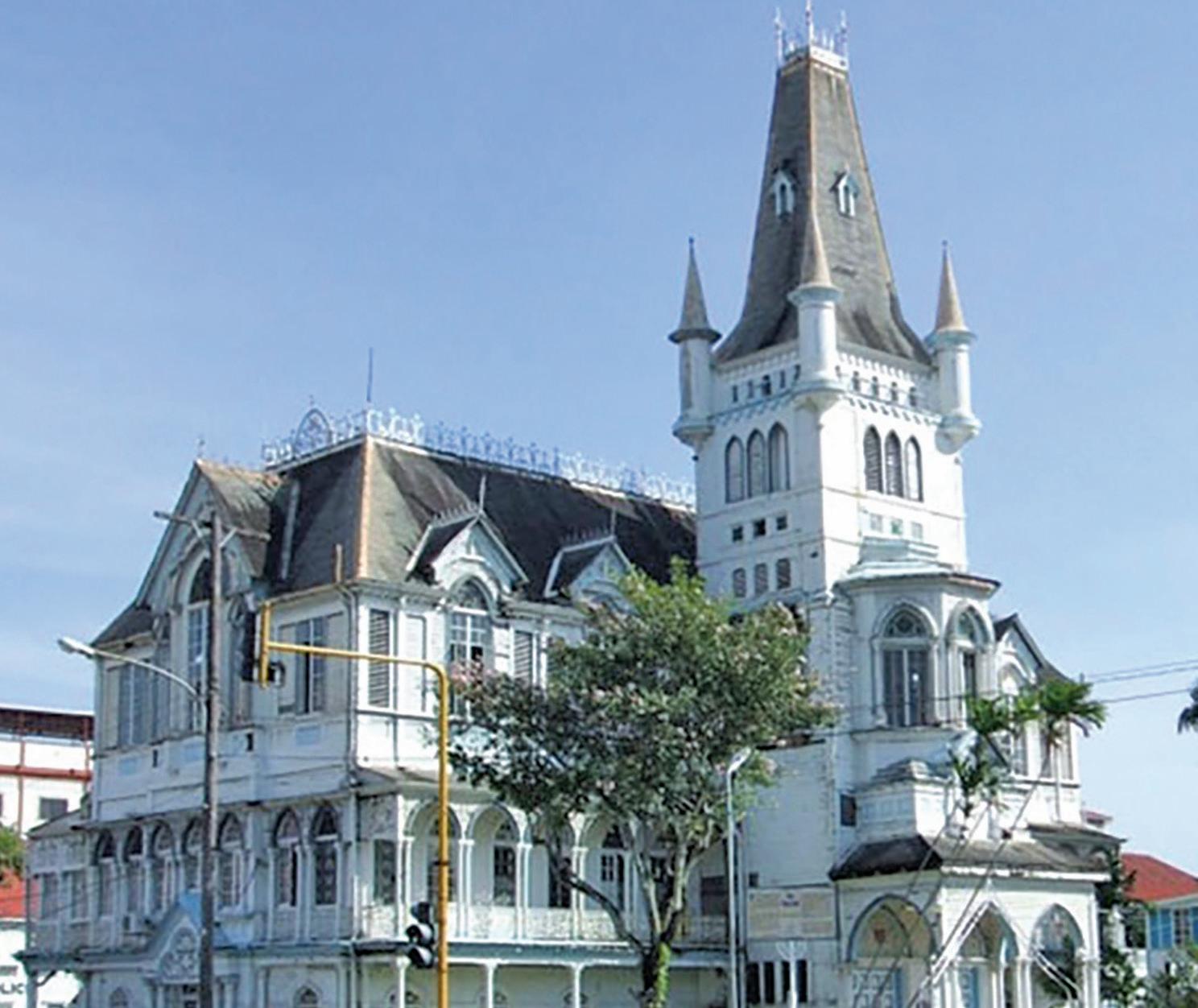
By Janet Daly
What has gone wrong with the Western model of government? You would not guess it from the teeming hordes of people who are clamouring to gain entry into what they obviously see as the most fortunate countries on Earth, but the nations which were once believed to have found the perfect formula for human happiness and fulfilment are slowly but inexorably crashing.
Their economies – which had been the means of delivering a prosperity that produced unprecedented degrees of personal freedom and satisfaction – are now unsustainable. How have we got here? How could the miracles of enterprise and resourcefulness which had transformed social conditions and individual possibilities just over a century ago be so exhausted that sensible people now speak in terms of outright despair at the prospects for the next generation?
What happened was simply this. Over the course of the 20th century, with its terrible wars and traumatic financial catastrophes, the Western political ideal shifted from democratic capitalism to democratic socialism.
The ruthlessness that the rise of capitalist adventurism required was just about tolerable until the Earth-shaking events of the Depression and two world wars which gave a new force to the idea of collective social responsibility. The charitable movements which had attempted to rescue the poor and unfortunate were no longer enough. There was an almost universal sense that society at large – in the form of elected governments – had a moral obligation to intervene for the wider good.
In America, this shift was propelled by the stock market
crash of 1929 and the Great Depression that followed, which produced national trauma of a magnitude which is now almost unimaginable. (My parents’ generation in America spoke of the Depression as if it were a catastrophic biblical event.)
Franklin Roosevelt’s presidency launched welfare programmes – which had once been alien to the national character –and federal work projects to provide illusory employment, but the puritan work ethic meant that there was (and still is) a constant tension between direct government assistance and the sacred American principle of self-reliance.
In Europe, the context was very different. Here, there had always been a tradition of noblesse oblige: people born with privilege were expected to care about and – in an almost feudal sense – take responsibility for those who did not have their advantages.
After the two world wars, there was a newly-revived sense of obligation to working-class people who had endured danger, hardship and deprivation with such courage and fortitude. Most European countries inaugurated forms of state-sponsored healthcare and social welfare in the years after the Second World War which displaced the old, largely church-sponsored, agencies. Many of the original hospitals run by the National Health Service were former charitable institutions that had been founded to provide medical care for the poor.
It became inconceivable, in respectable political discourse, to reject the idea that democratic government had a responsibility to protect all of its citizens from debilitating poverty, treatable illness and gross social disadvantage. Capitalism, administered by a morally-responsible government, had to accept this as part of its mission. All of this
seems unquestionably admirable: human decency had to prevail over the unfettered “animal spirits” that drive relentless economic progress.
So what went wrong? Why are our attempts to create an ethically-acceptable state, funded by free markets (which is the definition of democratic socialism) becoming untenable? As the identity crisis of the West becomes more deranging, both halves of this idealistic formula – democracy and socialism – are becoming contentious.
The socialism part has simply turned out to be infinitely expensive. As Kemi Badenoch put it last week, the United Kingdom is now in danger of becoming “a welfare state with an economy attached”. Once the principle of relieving poverty became a commitment to removing all wealth inequality, the project was headed for self-destruction.
By an inexorable process –often propelled by people who did not believe in capitalism or democracy – the goal of eradicating genuine hardship and needless suffering became a much more far-reaching plan for the total transformation of society. Carried to its logical conclusion, this involves extracting so much from the productive forces in the economy that it undermines the very source of the wealth that is meant to be redistributed.
The Western economies are now in the process of bankrupting themselves in the quest for an ideal state of “fairness” which has undermined the capitalist dynamic of wealth creation. But the “humane” image of a population which is determined to relieve any vestige of disadvantage propels this futile project ever onwards.
This is a coercive moral trap from which we cannot escape even though its conceptual flaws are clearly visible. Even its most basic principles
are controversial: does a “fair” society really mean abolishing all inequalities of wealth? Or offering unquestioned support to all those who claim to need it? What the word “fair” means to most people is “you get out of life pretty much what you put in”. Is there any serious political leader who would be prepared to utter that proposition now? The “socialist” half of this formula has become an ever-more relentless dogma which the “democracy” half must always serve. Indeed, the common understanding is now that a government is not truly democratic if it does not subscribe to the orthodoxy of economic equality. This new understanding of the function of elected government is being strenuously pushed by those who argue that The Law must take sacred precedence over politics, which may be practised by rogues and opportunists.
The proponents of this view (like the Attorney General, Lord Hermer) see themselves as defending laws that embody moral absolutes. This concept is borrowed from the US whose Constitution gives such power to the Judiciary over elected legislators and Presidents. Tony Blair began this emulation of the American system by renaming the Law Lords as the Supreme Court. This has no legitimacy in Britain where Parliament is sovereign and may pass whatever law it sees fit. Perhaps the Hermer doctrine is where democratic socialism was bound to end: the only hope of salvaging socialist principles is to undermine the democratic ones. (The Telegraph) Janet Daley was born in the United States and taught philosophy before beginning her political life on the Left (before moving to Britain, and the Right, in 1965) – all factors that inform her incisive writing on policy and politicians.
Dear Editor,
The first order of business, or the most important task for the next PPP/C Government, is the establishment of a modern water supply system, enhanced with all the 21st century fittings. We are here talking about water quality, that is,
water that has been chlorinated, fluorinated and ozonized; suitable for the health and general wellbeing of the nation.
A crucial part of our development is safe potable water supply; one that runs on a 24-hour basis, and water flow pressure that reach-
es approximately two storeys high.
What obtains at the present moment, is a glorified update of the historical standpipe arrangement, wherein the water pressure can only flow at ground level. Those upper flats dwellers have to come down to the
ground floor to get water, which is very irritating to say the least.
Those of us who are a little more affluent, have to get a pump mechanism to get water up to the upper floors.
This is unacceptable in any modern society. At this stage of our development,
where all other sectors have seen massive development, potable drinking water lags behind.
Note well, marked improvement has been made in Guyana, bringing drinking water to residents where none existed. However, much more needs to be done to get us to where modern levels of safe healthy water supply should be – and at a rate of flow that makes for comfortable living. This critical area has to be addressed urgently!
Yours sincerely, Neil Adams
Dear Editor,
I’m writing as a Guyanese who cares deeply about our country’s future.
Ambassador Nicole Theriot’s remarks in Guyana today shouldn’t be dismissed, they are a wake-up call to all of us. She warned in no uncertain term, that the candidacy of Mr Azruddin Mohamed, a businessman recently sanctioned by OFAC, threatens our ties with both the US Government and American companies.
She said that anytime a US-sanctioned person steps into Government, “it is concerning for us and problematic in multiple ways”.
Let that sink in. This isn’t political spin, it's a blunt message. Our international relationships may
suffer unless we deal with this issue clearly and urgently.
She added that if Mohamed wins a seat even in a committee, the US would have to be very careful. Support for initiatives could dry up, and direct collaboration could disappear. She also addressed what many of us fear: American investors pulling out.
“All these US companies want to come to Guyana, I don’t want that to change,” she said, warning they might “de-risk or cut ties” if someone under sanction gains political influence. That’s not just diplomatic chatter it’s a risk to our economy and livelihoods.
The reason? OFAC sanctions were issued against Mohamed and his father on June 11, 2024,


for alleged large-scale tax evasion and corruption involving over $50 million in gold exports. Immediately after that, Guyanese banks moved fast – all commercial banks cut ties with the Mohameds to protect themselves.
It’s a textbook example of how a sanctioned individual triggers a compliance shutdown.
Vice Bharrat Jagdeo later reaffirmed the Government's stance: no individual is worth risking the future of all Guyanese. He made it clear that engaging with OFAC sanctioned persons puts our entire financial system at risk. And rightly so.
From where I stand, this isn’t about targeting one person. It’s about protecting a fragile trust we’ve spent years earning.
In 2014, Guyana was grey-listed by the FATF (Financial Action Task Force) for lapses in anti-money laundering laws. It took snap elections in 2015 and urgent reform to avoid full blacklisting, a scenario that could have strangled our ability to trade and grow.
Electing a sanctioned figure now could trigger all that damage again in different ways. It sends a message that compliance doesn’t matter. It reminds investors that our legal frameworks are weaker than portrayed. These are not far-fetched hypotheticals, they are documented risks. Ambassador Theriot also shared that US Embassy officials will watch the upcoming elections closely as observers. Her presence means

she’s monitoring whether Guyana remains committed to transparency and rule of law.
This is a crossroads. We can’t let short-term popularity choices undermine our long-term standing. We need leadership that reinforces anti-corruption, respects global standards, and keeps doors open both diplomatically and economically.
As a Guyanese, I refuse to see our nation stumble because we didn’t take compliance seriously. If we tolerate the candidacy of an OFAC sanctioned person, we risk not just a tinge of embarrassment but a genuine crisis. Let’s this moment lead us forward not backward.
Your sincerely, Alvin Hamilton



Learning these properties will make your mathematics work easier.
Did you ever try to multiply by 0? The answer is 0.
Zero property of multiplication: Any number x 0 = 0.

Remember that an equation is a mathematical statement that two things are equal. 4 + 2 = 1 + 5
Equality Property of Addition: If you add a number on one side of an equation, you must add the same number on the other side of the equation. Both sides will then still be equal. (4 + 2) + 6 = (1 + 5) + 6
Equality Property of Subtraction: If you subtract a number on one side of an equation, you must subtract the same number on the other side of the equation. Both sides will then still be equal. (4 + 2) – 2 = (1 + 5) – 2
Equality Property of Multiplication: If you multiply one side of an equation by a number, you must multiply the other side of the equation by the same number. Both sides will then still be equal. (4 + 2) x 8 = (1 + 5) x 8
Equality Property of Division: If you divide one side of an equation by a number, you must divide the other side of the equation by the same number. Both sides will then still be equal. But you never divide by 0. (4 + 2) ÷ 9 = (1 + 5) ÷ 9



Answer yes or no






By RichaRd WilBuR
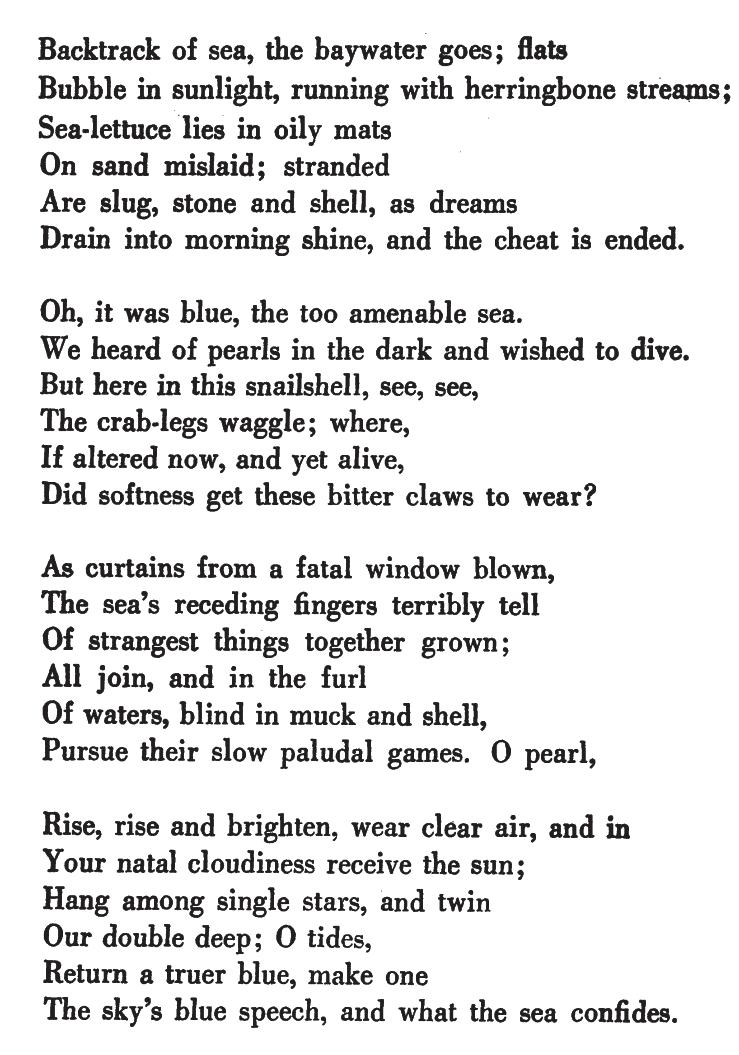

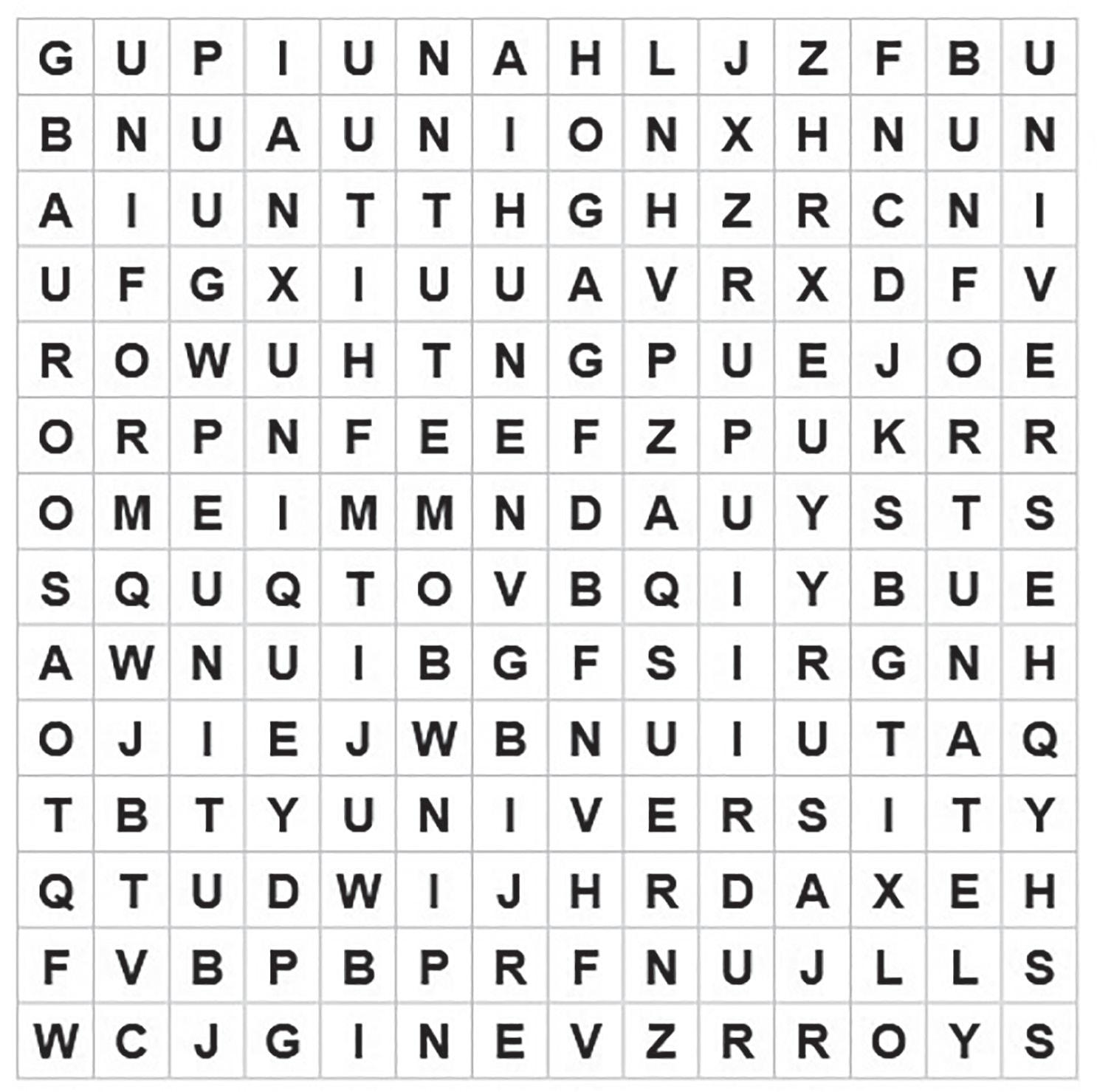
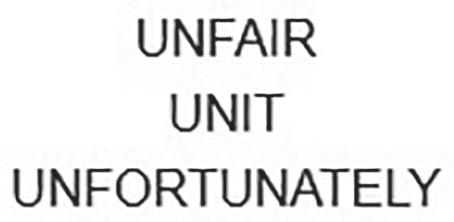
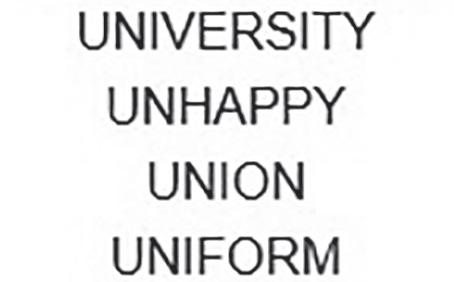
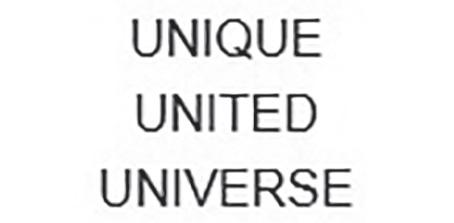

The East Bank
Demerara (EBD)
Public Road was reopened to vehicular traffic on Sunday afternoon – nearly 12 hours ahead of schedule following the timely completion of asphalt work on the new Demerara River Bridge.
The road, between the Ramada Princess Hotel and Nandy Park, was initially slated to be closed off to all vehicular and pedestrian traffic
from Saturday, July 26, 2025 at 02:00h until Monday, July 28, 2025 at 04:00h. This closure was to facilitate the laying of asphalt on the bridge’s surface on the eastern side that runs overhead the EBD public road.
Public Works Minister Juan Edghill, told the Guyana Times on Sunday evening that the works were completed way ahead of schedule.
“They were placing the asphalt on the carriageway [of the bridge’s surface] … And they finished and reopened the road since 5 o’clock [Sunday] afternoon –so almost 12 hours ahead of schedule,” Edghill stated.
The contractor, China Railway Construction (International) Limited, has been working around the clock to finish the US$262 million bridge in time for
Nothing done by APNU, AFC to regain trust of electorate – Dominic Gaskin ...says campaign “sweeteners” will not cut it for Opposition parties
Former Minister under the A Partnership for National Unity+Alliance For Change (APNU/AFC) Government, Dominic Gaskin, believes that the promises being made to the electorate by these two parties on the current elections campaign trail are futile since there were no attempts made by either APNU or AFC to regain the trust lost after the 2020 polls. Gaskin, who served as Minister of Business between 2015 to 2020 under the coalition regime was the first official from that camp to call out the blatant attempts to rig the March 2, 2020 election results.
Since then, he has not been involved in politics and is no longer attached to any political party – focusing over the past five years on his jewellery business. However, prior to his withdrawal from the political scene, Gaskin – the son-in-law of former President David Granger and a former Executive Member of the AFC – had urged the APNU+AFC to work on regaining the public’s trust leading up to the 2020 polls. But during an appearance on this week’s edition of the Starting Point podcast, Gaskin says the two former coalition partners, which are contesting the upcoming September 1 General and Regional Elections independently have done nothing to rebuild their credibility among Guyanese voters.
“I’ve seen nothing over the last five years from either the APNU or the AFC that says to me ‘Look, we’ve examined the situation. We’ve done some internal agonising and investigations and so, and here is our take on it.’ Their comfort zone seems to be just ignoring it and hoping it will go away… Ignoring what took place…in that five-month period, pretending it didn’t happen and worst yet, even questioning the legitimacy of the current Government. It doesn’t help the opposition to do that and it certainly does not regain the trust or the support that they lost,” Gaskin contended. Days after the March 2, 2020, polls, Gaskin had broken ranks with
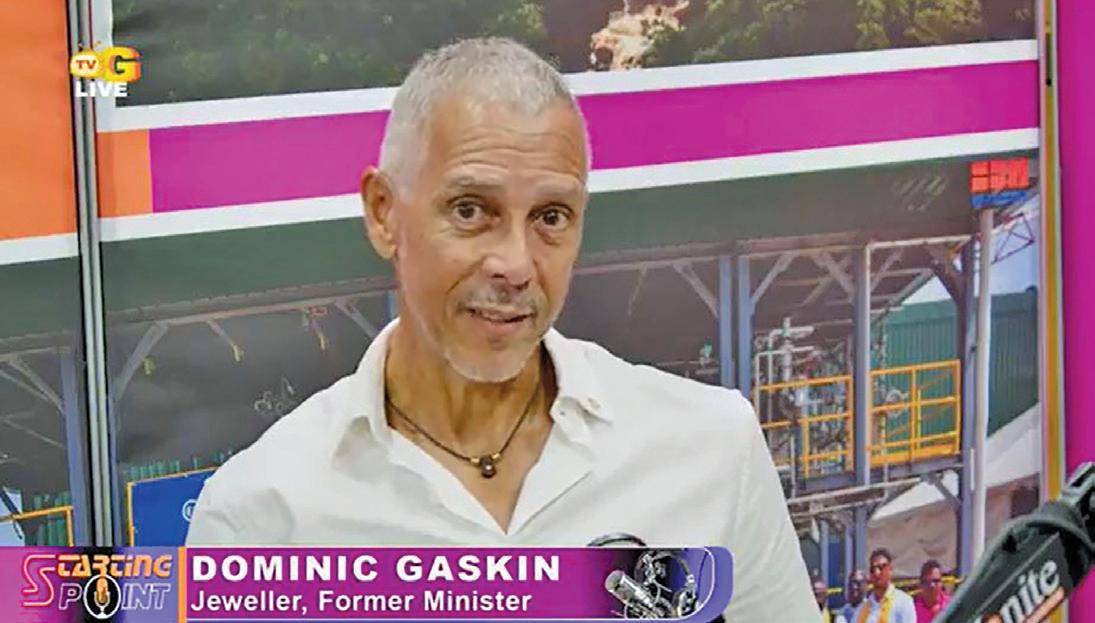
the coalition and spoke out against the rigging attempts – something which he continued to do during the tumultuous five-month period after the March 2 polls until the Granger Administration finally conceded defeat and the People’s Progressive Party/ Civic (PPP/C) was sworn into office on August 2, 2020.
Several former high-ranking electoral officials along with politicians in the then Coalition administration are currently facing legal proceedings over their roles in attempting to alter the 2020 election results.
Sweeteners will not sway votes
Five years later, on the cusp of another General and Region Elections, the former coalition Minister says that nothing the APNU or AFC does or promises to the electorate would hold any political weight. “Promises will get you some votes but I’ve already commented on what I think the outcome of this election is going to be… I don’t see that outcome changing because of these promises. I think, yes, you can make last minute campaign promises…but by and large people will vote for you based on your performance over the last five years and not swayed by the sweeteners you handout in last few weeks of your campaign,” he posited.
Last October, Gaskin appeared on a television programme where he said the events during the last elections has caused the APNU+AFC two election losses – 2020 and 2025. In fact, he had predicted that the ruling PPP/C would return to office
at the 2025 polls. Recalling his actions back in 2020 that was largely seen a blow to the coalition, Gaskin declared that it was the right thing to do especially since he fiercely believes in the democratic right and will of the people.
“[Losing] wasn’t something that we had to be ashamed of and it wasn’t something that was totally unexpected because our elections have always been close… The numbers that were presented for Region Four [Guyana’s largest voting district and the source of contention during the 2020 elections] were clearly the wrong numbers. They didn’t match with anything that I had seen beforehand or was published… The numbers were literally pulled from a hat just to make up the amount that would take us past over the 50 per cent mark, and that was obvious to anyone who was paying close attention to the numbers.”
“So, I can’t look at something like that and be a party to it or even want to benefit from it. That didn’t sit well with me. I feel very strong about elections and how we treat with the people’s will. It’s only once every five years that Guyanese get a chance to make a difference and to deny them an opportunity to make a difference – whether you agree with what the majority voted for or not – I think it’s wrong, fundamentally wrong and I think it would have been bad for Guyana,” he contended. According to Gaskin, he did not face any backlash over his political stance in 2020, noting that he has always maintained good relations with his former coalition colleagues.
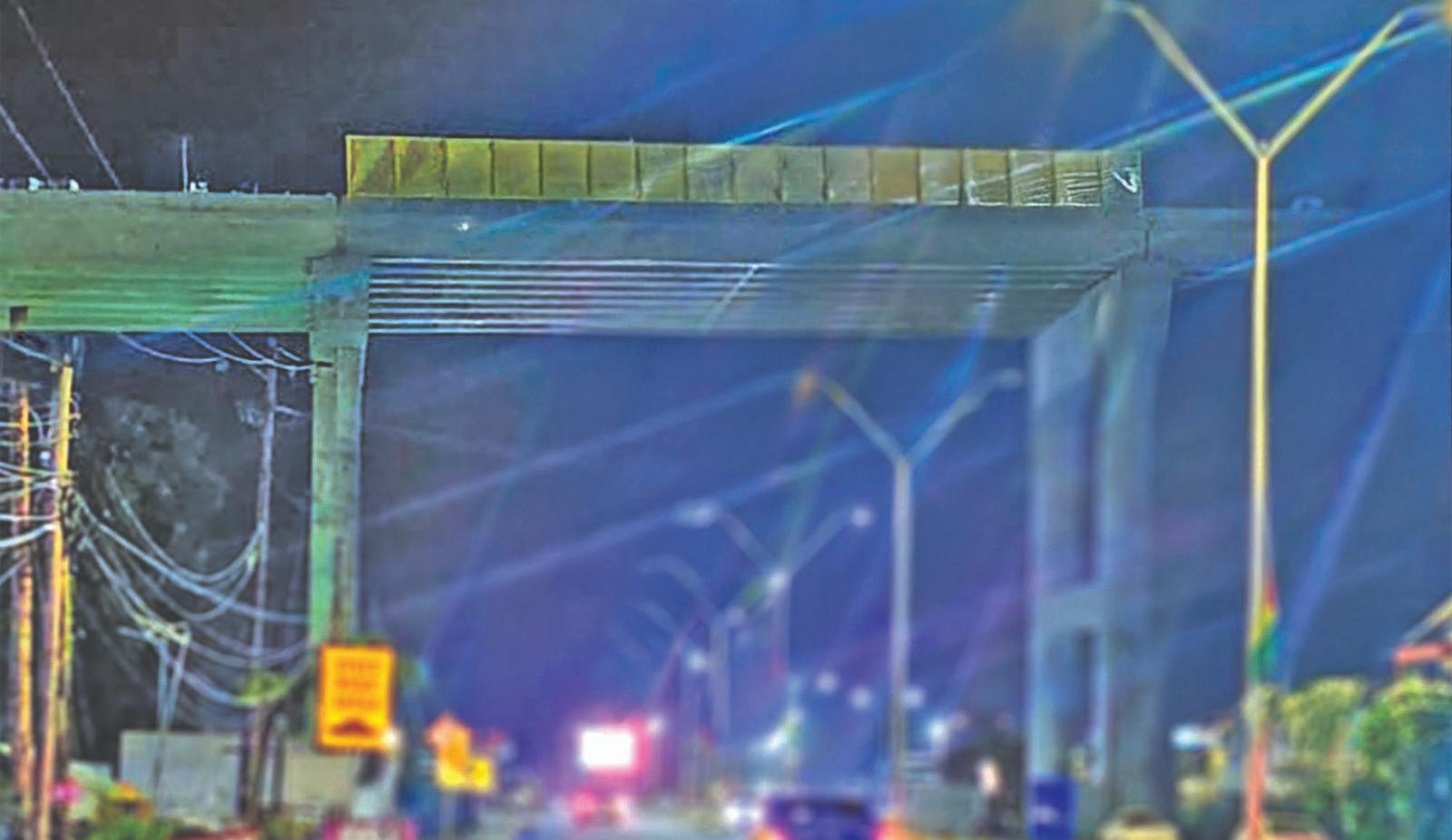
Asphalt work completed on the new Demerara River Bridge the August 31, 2025, deadline. According to the Public Works Minister, this deadline is still on the cards. “The bridge is scheduled for August 31 completion,” Edghill contended.
However, despite this assurance that the bridge will be completed next month –just one day before General and Regional Elections are held on September 1, Vice President (VP) Dr Bharrat Jagdeo, recently stated that the Government is prioritising safety and structural integrity over political timelines.
“They’re now hooking up the final span across. It will be very soon. You can see that if you drive across. But we’re not going to push them to meet an artificial deadline just for the sake of the elections. The people in Region Three and Region Four who use that bridge and every
other region, see it every day. They know what’s the commitment we made. To get a structure up like that in such a short period of time, basically it’s three years after COVID. A structure like that nearing completion and with the highways, all the associated highways, is phenomenal,” the VP said at a press conference last week.
The new bridge would be a 2.65-kilometre (km) fixed four-lane, high-span, cable-stayed structure across the Demerara River, with the width of the driving surface being about 23.6 metres.
With features like a bicycle lane, the new bridge will replace the ageing floating Demerara Harbour Bridge (DHB) and would bring to an end to the closure of vehicular traffic with a 50-metre fixed-high span to cater for the free and uninterrupted flow of vessels. The riv-
er would be dredged along a 13.5-km stretch to accommodate large vessels.
Once completed, the new bridge and extensive road upgrades along the EBD are expected to significantly reduce traffic congestion and travel time. In fact, extensive road works are currently being executed aback Nandy Park to facilitate traffic that would come off of the new bridge, taking it straight to the Heroes Highway. Once complete, the bridge will connect Regions Three and Four, improving economic activity. The toll-free crossing will accommodate vehicles of all sizes, with a speed limit of 80km/h. Designed to last at least 100 years, the new Demerara River Bridge will also feature the Cacique Crown of Honour (CCH), Guyana’s second-highest national award, as part of its design.
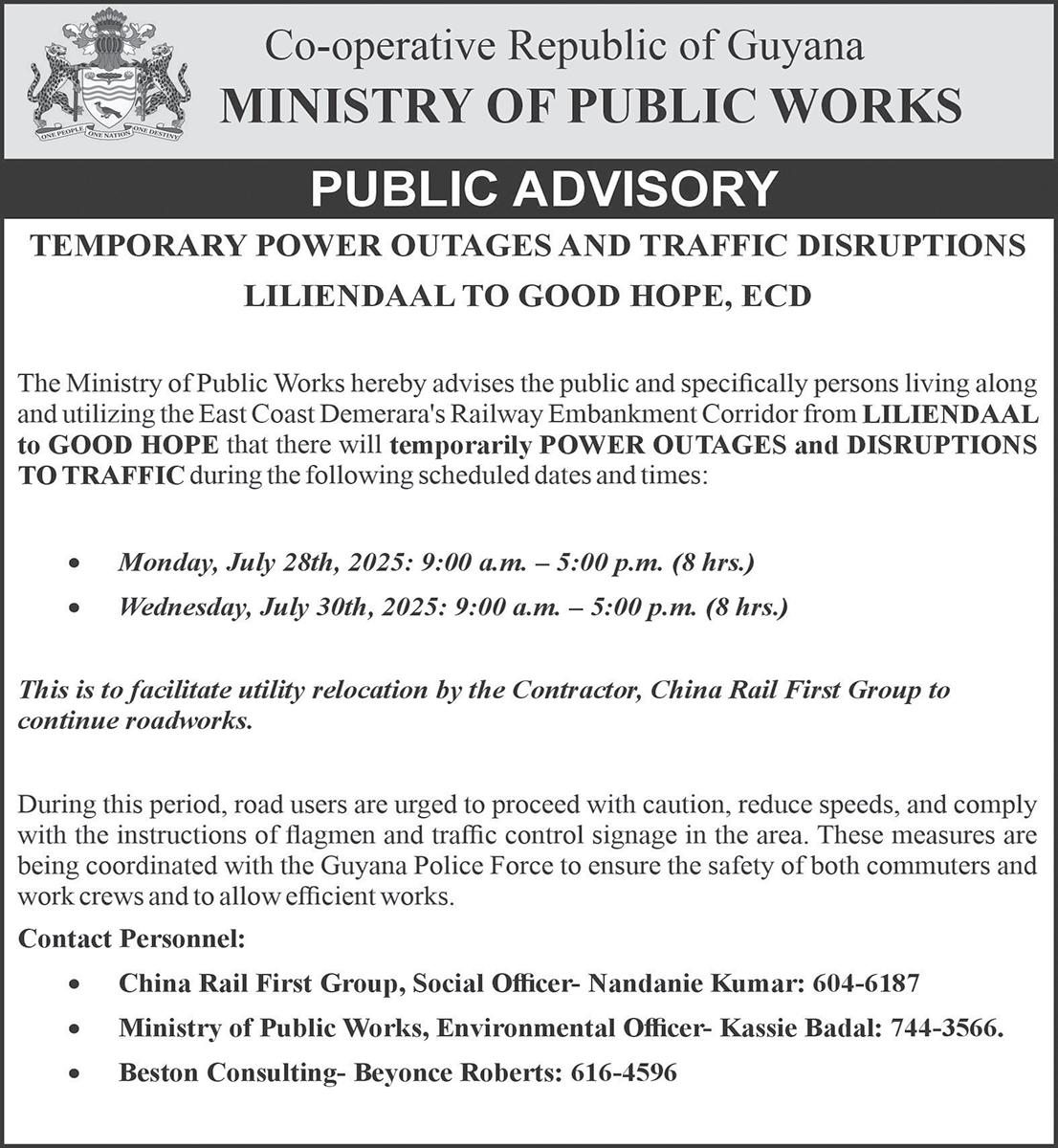

Guyana’s traffic authorities are stepping up efforts to clamp down on illegal vehicle modifications, including coloured headlights, fancy number plates, and excessively tinted windows, especially windshields. On a recent televised programme that was hosted by the National Road Safety Council, police officers say these cosmetic alterations not only breach vehicle fitness laws but also endanger lives by impairing visibility, especially at night and during rain. Inspector Roberts, who is in charge of traffic at the Tuschen Police Station under Regional Division 3 (Essequibo Island- West Demerara), said the police continue to monitor high-risk areas along the West Coast corridor. He explained that the division has been focusing on both education and enforcement to curb reckless driving and ensure greater compliance with road safety regulations.

by younger drivers. “They bought a vehicle and they started decorating it with various things,” one officer remarked. “You are not supposed to alter or put on anything. And if you need to do that, you need to then go back to the authorities to have it included on the vehicle.” The problem extends to fancy or non-reflective number plates that make it difficult for speed cameras to identify vehicles.
Heavily tinted windscreens remain a sore issue, particularly since some drivers must roll down their windows to see during rainstorms. “When the rain falls, some of these same drivers have to wind down their driving window to peep to see where they’re going,”

A“The law clearly states that you must have two white lights on the front of your vehicle,” explained one officer. “Although we find drivers are taking out the light that the vehicle comes with and putting in a colour, like they have blue, they have different colours.” Through an ongoing “White Light Campaign,” traffic ranks in that division are revoking fitness certificates and charging drivers for breach of prescribed fitness. “They are given a day or two later to bring the vehicle back to the station to be examined. We identify all the defects. And then they will receive all the fitness,” the officer added.
Chairman of the National Road Safety Council, Earl Lambert, noted Despite ongoing enforcement, some drivers continue to reapply tint after being warned or charged.
The growing trend he says, is fuelled by a desire to stylise vehicles, mostly
Police have urged both the public and auto dealers to be part of the solution by avoiding the sale and use of unauthorised vehicle accessories.
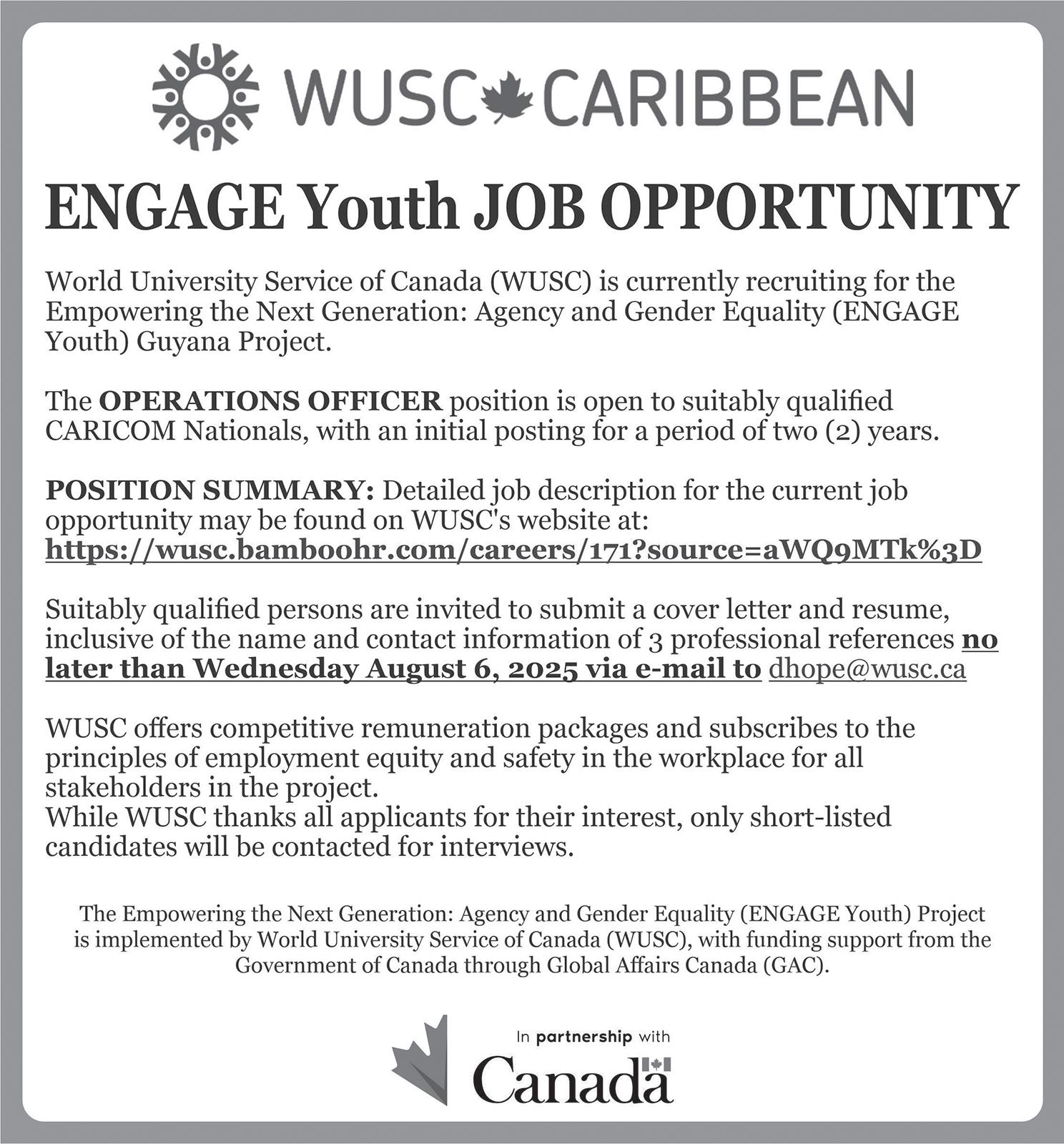
s the election campaign trundles on, we’re getting a clearer picture of what the competing parties think is “development”. The PNC claims to’ve dumped Burnham’s socialist path – whether “co-operative” or whatever – after total and unmitigated failure long before he died. But from Norton’s pronouncements and promises – as he speaks to the ever-dwindling faithful at campaign meetings – it’s clear he’s totally imbued with the guiding principle behind his hero’s ideological grasshopping! And what’s that principle, Dear Reader?? The Free Lunch Principle!! But ironically, the PNC already proved you can’t develop a country through handouts – by whatever name you call it – socialism or cash transfers or whatever. You can put lipstick on a pig – but it still remains a pig!! The bottom line is, even though the PNC once had the slogan “Produce or perish” painted on every blank wall they could find – it remained a slogan on walls!! They’re consumed by a seemingly atavistic drive that all their supporters must get a piece of the (economic) action for free. They seem incapable of accepting that those said supporters must sooner or later – and preferably sooner! – get their hands callused and grubby by ACTUALLY producing things!! If they don’t, then sooner or later – and most likely sooner! – they’ll end up with nothing in their smooth, uncalloused hands – since manna doesn’t drop from heaven no mo’ – if it ever did!! From their slogan, the PNC definitely KNEW of the importance of producing –and in Burnham’s case, they even took over “the means of production” – as they called the factories and fields. But by only stressing LIVING the good life rather than WORKING for the good life, they led their supporters to believe that woke rhetoric – about equity and equality – would lead them to the promised land of milk and honey! But it didn’t work then and it ain’t gonna work now!!
So Norton and the rest of the Opposition should quit playing the pied piper’s tune of annual million-dollar cash transfers and all the other freebies they’re promising. The economists would say it just ain’t “sustainable” – my granny said it much more punchier – moon a run till day ketch am!! Our oil’s gonna run out within a few decades – so where’s the funds to hand out gonna come from?? Haven’t we seen what happened to our neighbour Trinidad??
The PPP, on the other hand, isn’t oblivious to the reality that we started off from a poverty-stricken base – but their principle is folks need a hand up and NOT permanent handouts!! So they’re focusing first on building roads and bridges and other infrastructure like schools and hospitals – which will lead to attracting job-creating investments!!
And this is sustainable development!!
…on regional development
It’s rather sad the PNC/APNU continues to act as if Georgetown is Guyana and Guyana is Georgetown!! And imagine – if they could turn their heartbeat that’s our Garden City into a Garbage City – what would be the fate of the rest of the country!! Early in the day, they extended their gaze to Region 10 where Burnham created a town from three villages – Mackenzie, Wismar and Christianburg that he named “Linden” after himself – with a wave of his riding crop. But within the decade it lay in ruins where it’s been stuck.
Georgetown’s City Hall has now been returned to its Gothic splendour by the PPP – even though the responsibility lies with the PNC-controlled M&CC. And after five years, we can see the PPP’s plans for all the regions’ equitable development unfolding seamlessly. Last week, Berbice was informed of what’s ahead in the next five years as were the interior regions. Last Saturday, it was Essequibo Coast’s – Region 2’s – turn.
All Guyanese are equal!!
…being “smart flies”
The PNC originally encouraged the Sanctioned Man to go political – figuring he’d attract erstwhile PPP supporters. However, they’ve been caught with their pants down, now that they see their own supporters turning Blue!! Ain’t a pretty sight!!


Traffic officers from multiple regional divisions are ramping up enforcement against drivers who create unauthorised “third lanes” during peak hours, a practice that has become rampant across Guyana’s roadways.
The issue is especially prevalent in Regions Three (Essequibo Islands – West Demerara), 4B (East Bank Demerara), and 4C (East Coast Demerara), where drivers desperate to reach Georgetown or other destinations are forming illegal lanes, clogging intersections and creating hazardous traffic conditions. Officers say they’re fighting a daily battle.
During a recent episode of the televised programme Road Safety and You, Sergeant Mitchell Caleb, who is attached to the Cove and John Police Station on the East Coast of Demerara (ECD) as the Subordinate officer in charge of traffic, stated that in his division that
this issue is very prevalent.
“In Regional Division 4C, it’s prevalent. We have in the vicinity of Montrose, the road is very broad… persons who want to get to work for 8 o’clock and leave home, come into Georgetown at 7:45… [these] persons are making third lanes.”
He said their ranks are actively responding with motorcycle patrols stationed along known hotspots like Strathspey, Vigilance and Good Hope to curb this issue.
“We would have arrested several persons and prosecuted them for the offence,” Caleb said. “Also, some were prosecuted by way of summons. And we’re continually doing this. And we’re finding a reduction in some areas.”
But he said it is not always consistent, since drivers, even though they are warned and educated, choose to still violate the law.
“The say when the cat is away, the mouse will play. From the time the police are not there, persons get
back into this,” he added. “But we’re on their backs, and we’re getting good results.” Meanwhile, in region 4B, Sergeant Anthony, the traffic officer’s secretary, said careless driving charges have been laid against dozens of offenders caught in the act.
“We record when the drivers are being charged and sent before the court for the offence of careless driving,” said Sergeant Anthony. “So far, [we’ve recorded] some cases – 60-something cases.”
Police say the public has a role to play in helping reduce such behaviour by reporting rogue drivers, a point echoed in broader calls for collective responsibility in road safety. Only a few months ago, Traffic Chief Senior Superintendent Mahendra Singh also raised concerns over the growing issue of illegal second and third lane formation during peak hours on major Georgetown roads like Sheriff Street and Mandela Avenue. He described the
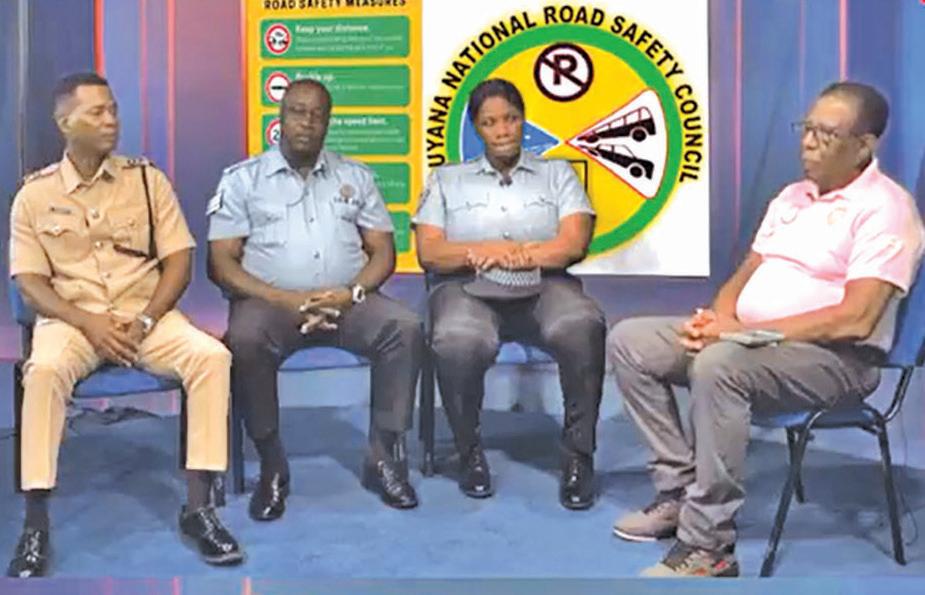
practice as "dangerous and careless driving" that endangers pedestrians, cyclists and all road users. While some drivers see these makeshift lanes as a way to ease congestion, Singh emphasised they create more confusion and increase accident risks.
He acknowledged the challenge of enforcement
due to limited police presence during rush hours, but stressed that this does not excuse drivers from breaking traffic laws. Singh proposed the use of technology, such as traffic cameras, to capture violators, which could deter rule-breaking and reduce the burden on traffic officers. Ultimately, Singh called for
a cultural shift in road behaviour, urging drivers to act responsibly, follow laws and prioritise safety over convenience.
He also suggested public education campaigns to promote defensive driving and change reckless attitudes that contribute to road chaos.
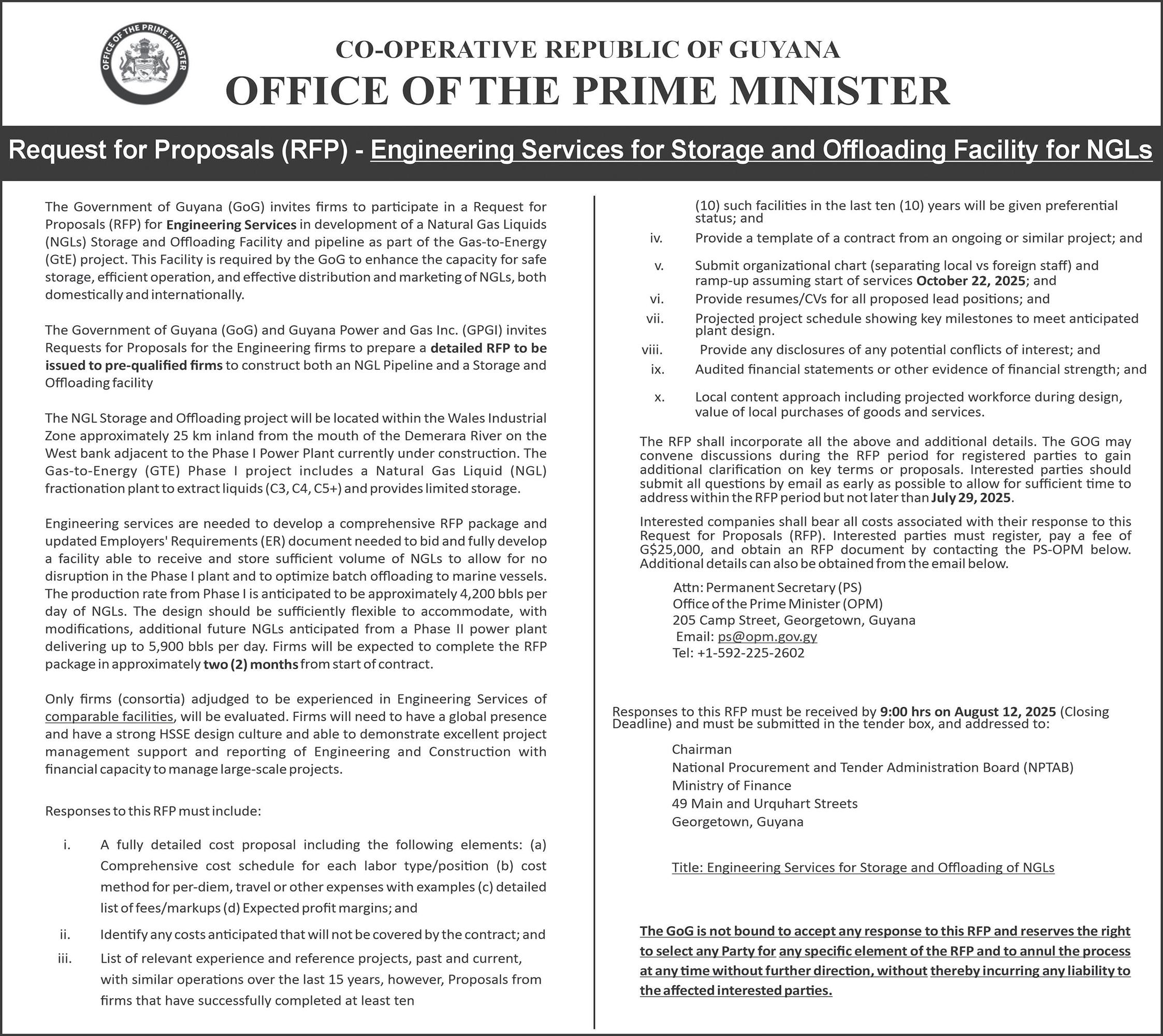

The Guyana Bank for Trade and Industry (GBTI) has recorded yet another strong performance with a profit after tax of $2.23 billion in the first half of 2025.
This represents a 24 per cent increase over the $1.80 billion recorded in the corresponding period in 2024, according to the unaudited financial results of GBTI and its subsidiaries, for the six months ending June 30, 2025.
“GBTI delivered a strong financial performance in the first half of 2025,” the bank’s Chairman, Suresh Beharry said in his first statement to shareholders
since assuming the position in June of this year. During this period, GBTI’s total assets grew by 41 per cent, rising from $209 billion to $249 billion which he says was driven by disciplined expansion in its loan and investment portfolios, enhanced operational efficiency and favourable market conditions. Additionally, Beharry noted that the bank’s capital and liquidity positions remain strong, reflecting their continued emphasis on prudent financial management and regulatory compliance.
In recognition of GBTI’s continued progress and solid half-year performance,
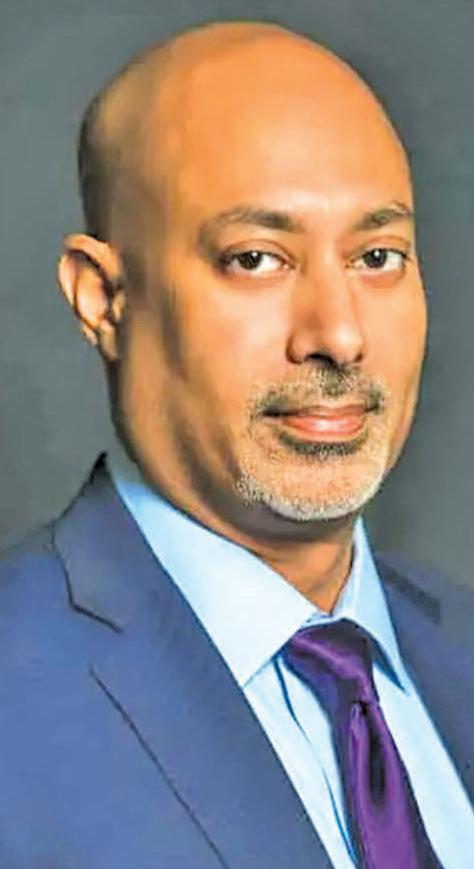

the Board of Directors has declared an interim dividend of $16 per share, reinforcing the long-standing commitment to delivering value to shareholders.
“This performance reflects the strength of our business fundamentals and the trust placed in us by our clients and partners across Guyana,’ the Chairman added.
Meanwhile, the increase in taxed profits reflects a continued growing trend for GBTI this year after previ-
attuned to these global and domestic trends and is committed to aligning our strategy with Guyana’s evolving economic landscape,” the Chairman stated.
Looking forward to the second half of 2025, Beharry said GBTI remains focused on executing its long-term strategy; one that prioritises client-centric growth, digital transformation, operational excellence and sustainable development. He added that the bank’s strategic
development and the aspirations of our clients and communities. We are confident in our ability to remain resilient in a dynamic environment and to continue delivering strong, sustainable returns,” the Chairman noted.
Beharry went on to extend on behalf of the Board, the bank’s appreciation to customers, shareholders, employees and regulators for their unwavering support and confidence in GBTI. Back in May 2025,

ously recording a 25.2 per cent hike in profit after tax during the first quarter of 2025. However, Beharry noted that the mid-year performance was delivered at a time when the global economic environment was marked by both opportunities and headwinds. Nevertheless, he noted that Guyana remains one of the world’s fastest-growing economies, supported by robust developments in the energy sector and sustained public and private sector investment. “As a systemically important financial institution, GBTI remains
investments in technology, risk management and talent development continue to drive innovation and improve customer experience across all segments. He also noted that, GBTI remains committed to supporting Guyana’s socio-economic transformation by facilitating access to financing, fostering financial inclusion and championing responsible banking practices.
“We remain cautiously optimistic about the remainder of 2025. As Guyana’s economy continues its positive trajectory, GBTI stands ready to support national
GBTI reported robust financial results at its 37th Annual General Meeting (AGM), revealing a 31 per cent year-on-year increase in profit after tax to $4 billion in 2024. The bank’s total assets also climbed to $249 billion; customer deposits rose by 24 per cent to $209 billion and the loan portfolio expanded by 12 per cent.
The Bank also reported a reduction in NonPerforming Loans (NPLs) to 3.85 per cent, signalling improved credit quality and effective risk management practices.


As the nation prepares for General and Regional Elections on September 1, 2025, President Dr Mohamed Irfaan Ali on Saturday evening outlined a comprehensive vision for development across Pomeroon, Charity, and other riverine communities, aimed at improving lives, reducing hardship and unlocking local economic potential.
Addressing thousands of residents at the Anna Regina Car Park, Anna Regina, during the launch of the Region Two (PomeroonSupenaam) rally, President Ali delivered a passionate message centred on dignity, empowerment, and inclusive growth.
er (hp) outboard engines; a move set to benefit residents in hinterland and riverine communities who rely heavily on such equipment for transportation, farming, and accessing markets.
“This is how we empower people, by making assets more available, by empowering them, by giving them the tools to be productive. Not by dishonouring them or believing they can be bought and sold,” President Ali stated
The Head of State further revealed that the Government has already committed to slashing duties on four-door pickups, making transportation more affordable for farmers and small business owners.
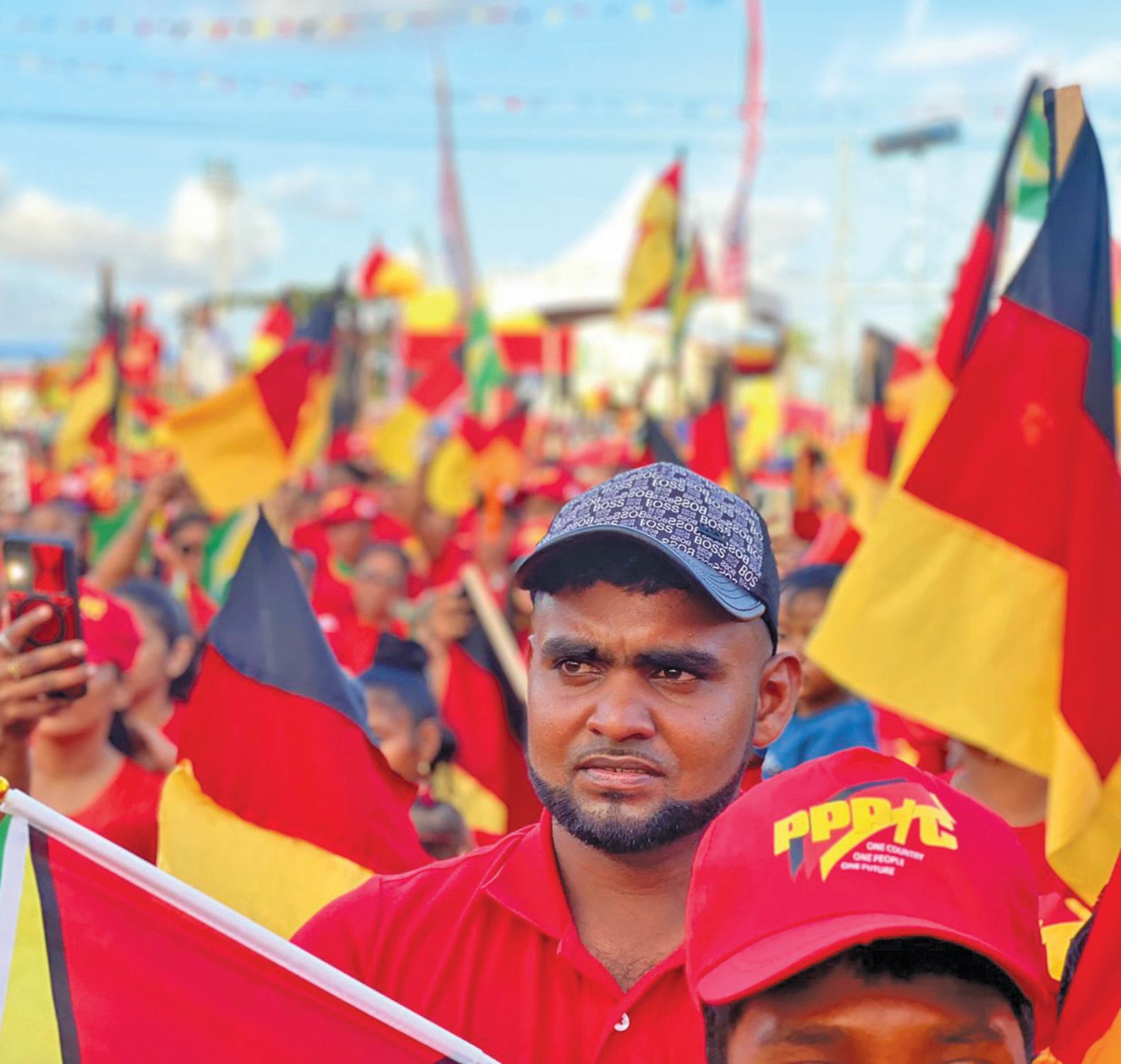
duty down substantially so that you can move on in
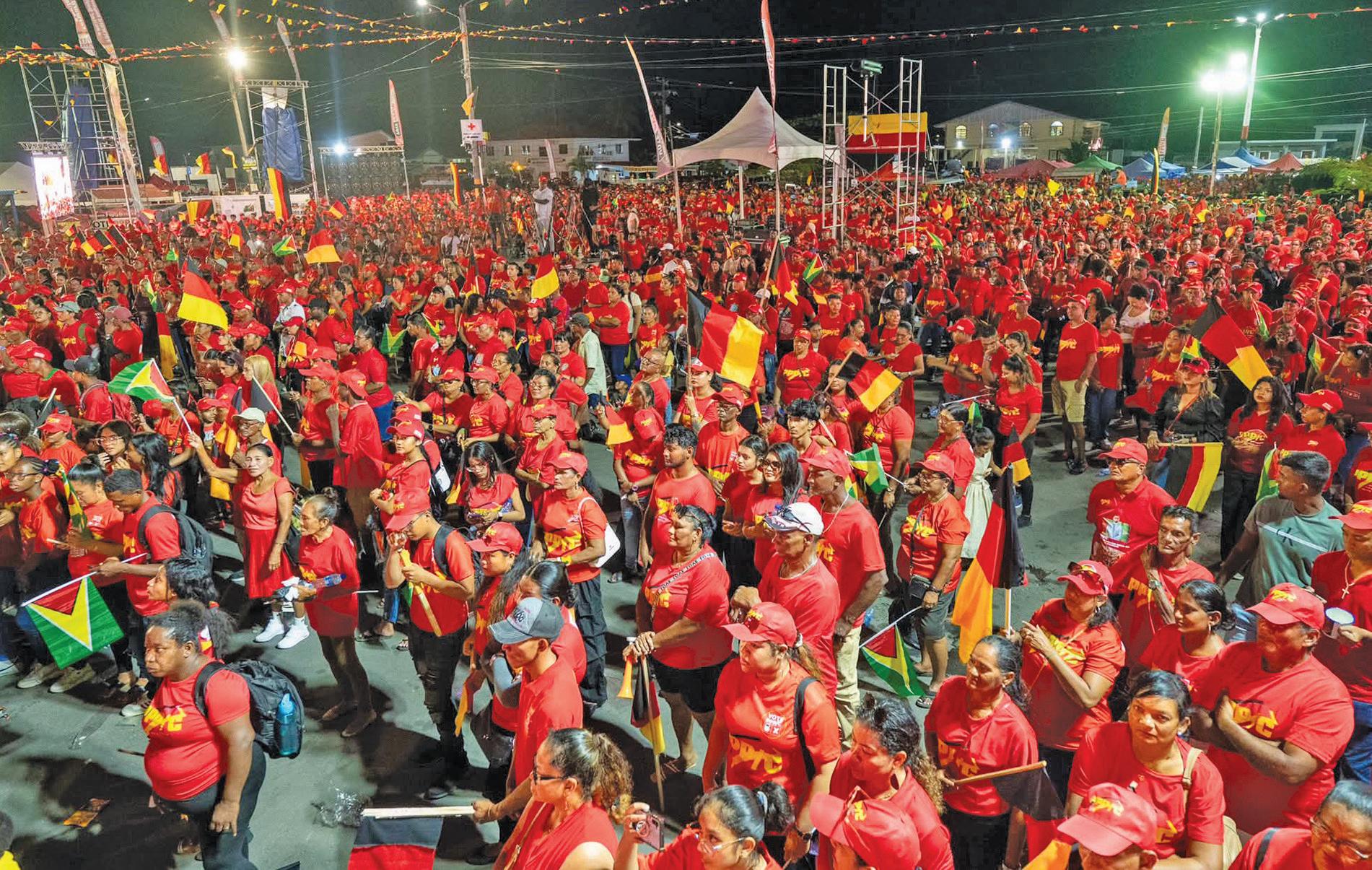
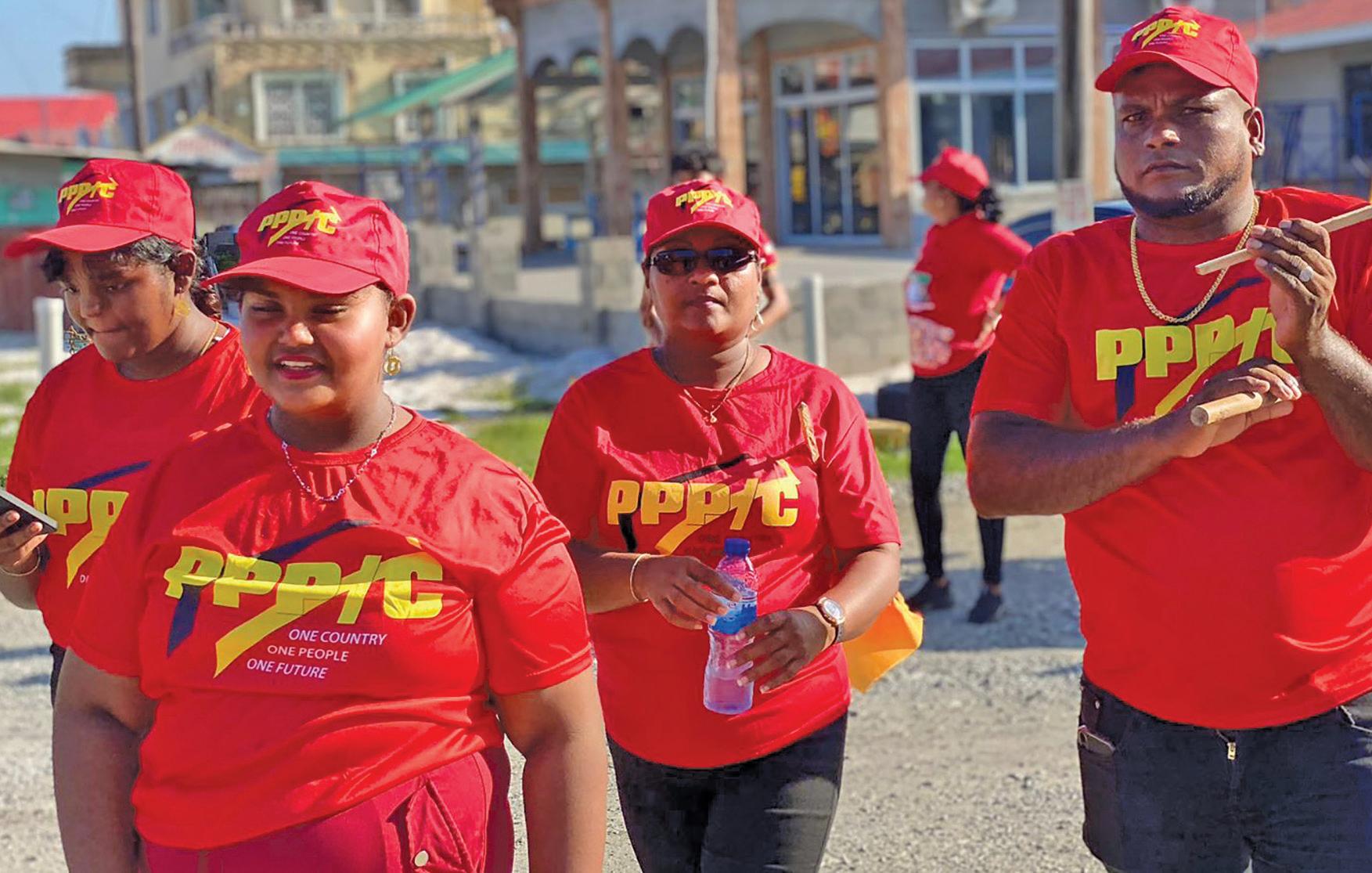
He announced that taxes will be removed on AllTerrain Vehicles (ATVs) and up to 150-horsepow-
“Many farmers come to me and say the four-by-four pickup duty too high.... so we are going to break the
your productive life,” he declared.
The President told residents that their votes on
September 1 represent a vote for homeownership, small business support, and economic independence.
“You are voting for more support to small businesses, for more money to be directly transferred to families, for co-investment opportunities, for low-interest rates at the bank and for a better system to support you in doing business with Government,” he said. Special mention was made of the need to expand the community forestry sector, with the President pledging incentives and access to machinery and equipment for small foresters and Community Forest Organisations (CFOs).
He also committed to investing in hinterland roads and market access roads, which will enhance connectivity and enable residents to reach and utilise their lands more easily.
President Ali highlighted the upcoming transformation of Charity into a hub of commerce and trade, saying, “When you vote on the 1st of September, you’re voting for the rebirth of the coffee and coconut sector, the new port at Charity and the expansion of markets for Pomeroon produce.”
He confidently stated that Pomeroon products, including banana, coffee and coconut will reach markets across the Caribbean as part of the region’s agricultural resurgence.
“Banana will be in the markets of the Caribbean. You are voting for access to finance, reduced interest rates, and land ownership.

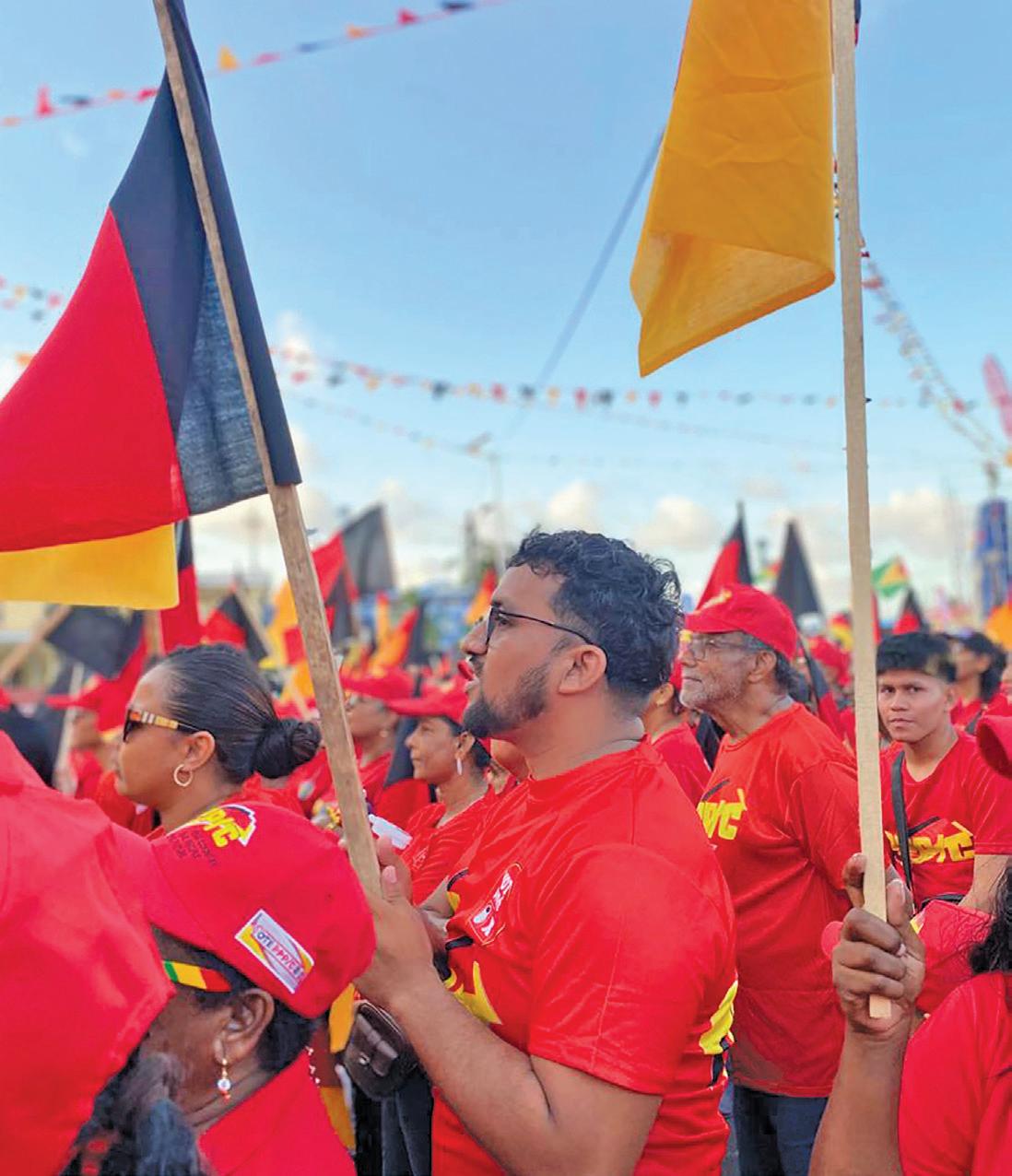
You are voting for equality of life, second to none in the Pomeroon,” the President asserted.
Reinforcing the Government’s people-centred approach, President Ali announced further support for housing, including more subsidies and assistance for families to build and own their homes. “You are voting for prosperity. You are voting for investment in your villages, for infrastructure in your communities and for more money in the pock-
ets of mothers, housewives, children, young people and pensioners,” he declared.
President Ali also reaffirmed that the September 1 vote is not merely a political exercise, but a vote for dignity, progress and self-reliance.
“This election is about your future. It is about empowering you, respecting your pride and your honour and building a life of opportunity right here in the communities you call home,” he stated.






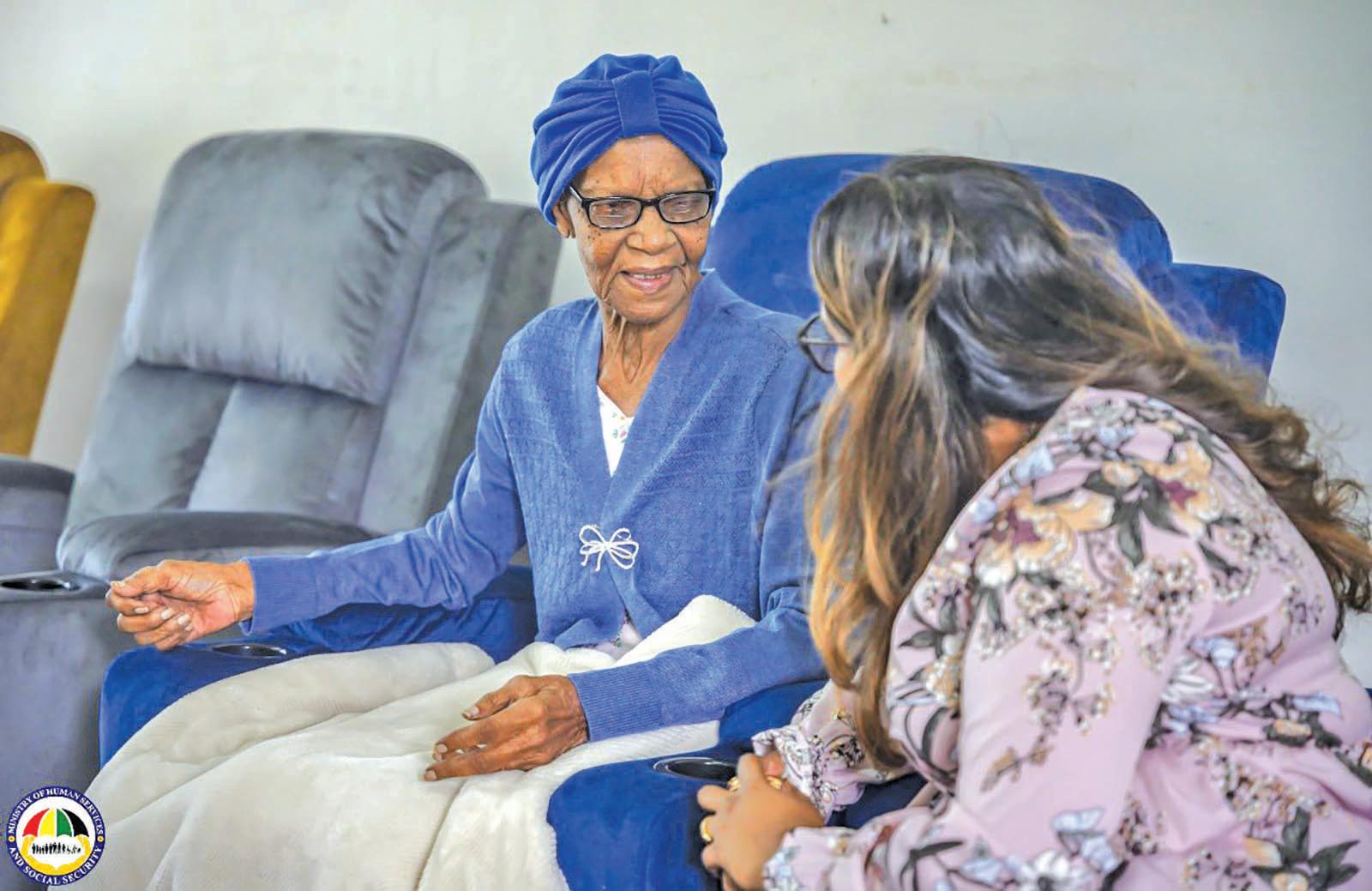
Geraldine Agatha Quintyn, affectionately known as “Gee,” celebrated her 101st birthday on Sunday, marking a remarkable milestone in a life defined by resilience, style, and unwavering grace.
Born in Lovely Lass Village, West Coast Berbice, Geraldine is the last surviving child of ten siblings born to Ram Dutchin and Beatrice Farrell. Among her siblings was her beloved twin sister, Rosalind, with whom she shared a close bond.
A proud mother and matriarch, Gee’s children include Yvonne Quintyn, Pam DeFreitas, Brenda Quintyn, and Royston
Quintyn. She also lovingly remembers her late daughter, Jacqueline France.
As a stepmother, she has nurtured Eslyn Samuels and Doyle Quintyn. Her legacy continues through 13 grandchildren and 7 great-grandchildren, who all hold her in the highest regard.
Geraldine’s life took a new turn in 1964 when she lost her husband, Samuel Quintyn. Since then, she has spent most of her adult years in Kitty, where she became a devoted member of the congregation at St. George’s Cathedral.
Known for her impeccable sense of fashion, Gee has long been regarded as a local style icon. Even at 101, she insists on be-
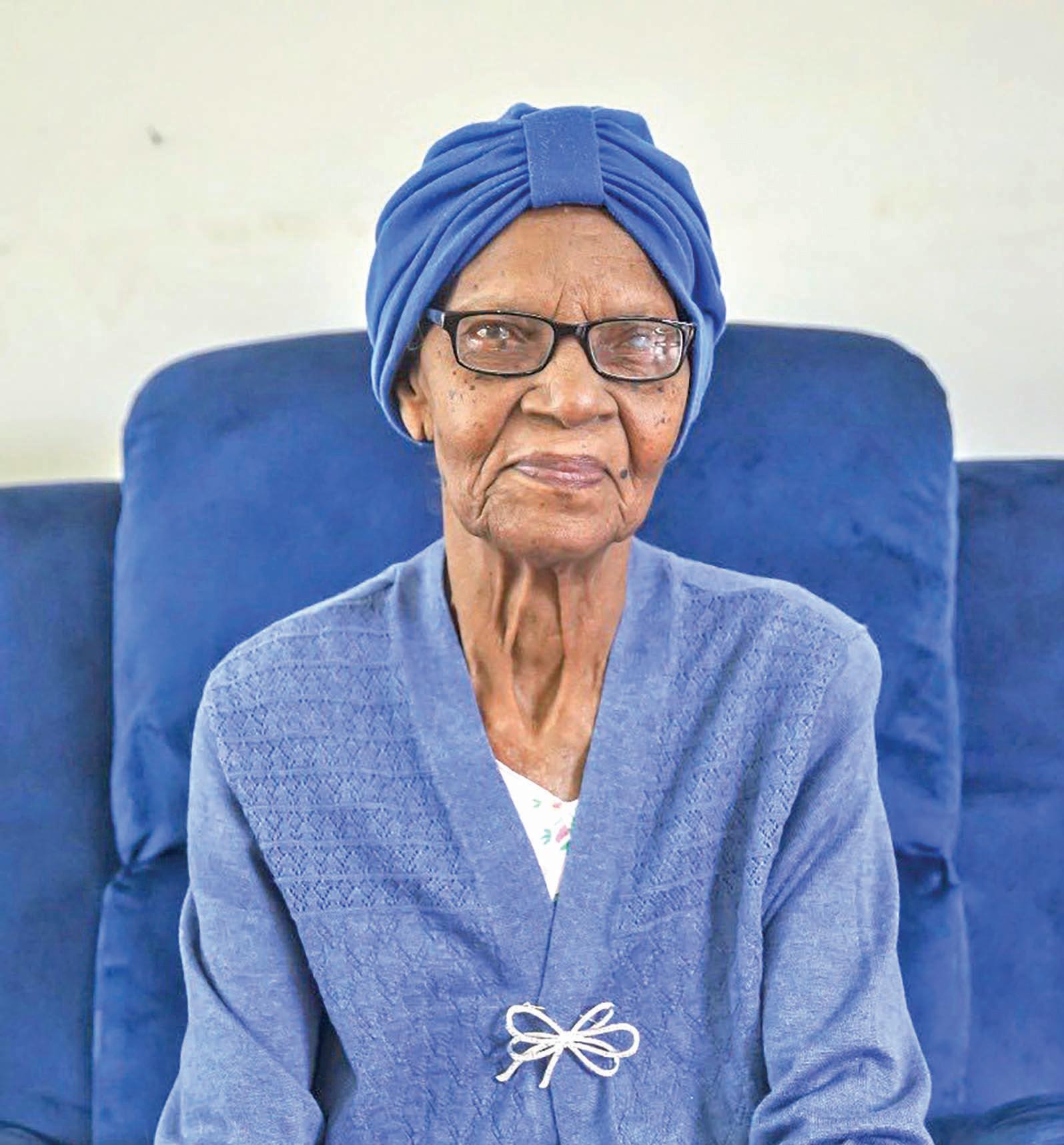
ing perfectly dressed before stepping out—be it for church or a doctor’s visit.
To honour her on this special occasion, the Difficult Circumstances Unit (DCU) paid a heartwarming visit to her home, presenting her with a thoughtful gift basket. The gesture, the team said, was a symbol of their appreciation for a woman who has exemplified strength, wisdom, and elegance for more than a century.
In 2022, in observance of October's Month of the Elderly, the Ministry of Human Services & Social Security had launched The Century Club – Extra Care for 100 Years and Beyond to honour Guyanese citizens aged 100 and older. T
The programme offers quarterly personal care packages, health checkups, monthly food hampers, fruit baskets, and assistive aids as needed. Home visits will also be conducted by ministry volunteers and WIIN trainees.
Minister Dr. Vindhya Persaud stated that the initiative acknowledges the contributions of the elderly and aims to improve their quality of life. She highlighted ongoing efforts to enhance pension services and emphasised that the Century Club is a tribute to those who have reached an exceptional milestone. Activities promoting wellness and mental health will also take place throughout the month.
With lawless driving on the rise, law enforcement officials are calling on members of the public to take an active role in road safety by using their smartphones to record and report dangerous behaviours. This was advised by Inspector Roberts, who is in charge of traffic at the Tuschen Police Station under Regional Division #3 (Essequibo Islands- West Demerara)
“Use your smartphone for the right thing,” urged Inspector Roberts. “The public can assist the police in dealing with this issue. They have their cell phones. They can record. They can take out a picture. They can send it to us.” He noted that even WhatsApp and social media platforms like
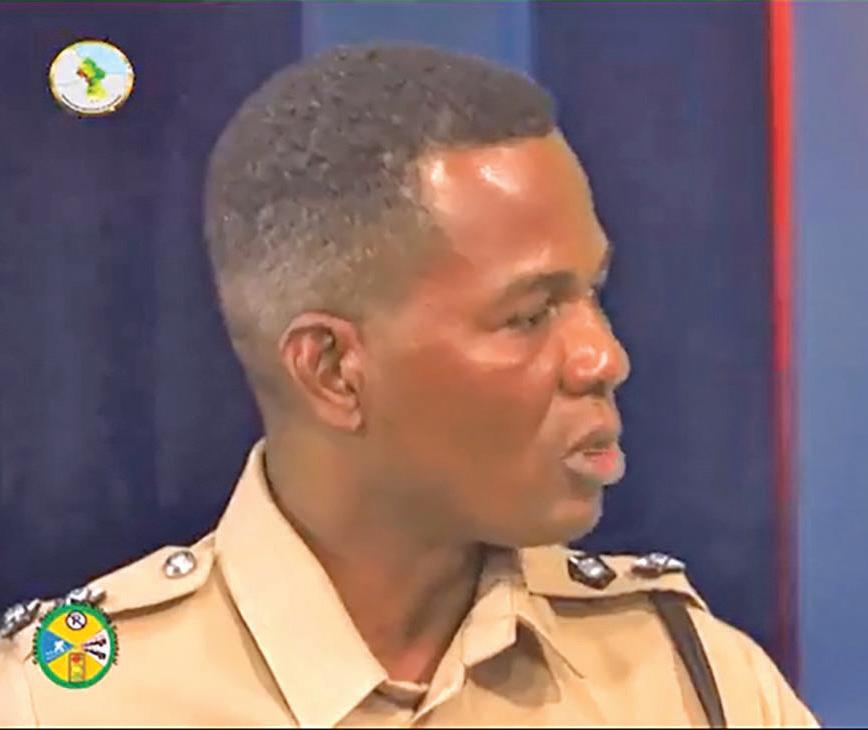
Facebook can help police track down and prosecute offenders. “The minute you record it and it’s up -
loaded on Facebook, I can assure you the police will go after those drivers,” he emphasised. He said too often, passengers in minibuses and private vehicles observe lawless behaviour silently, especially when rushing to work.
“Passengers sit in these buses and allow it to happen. They don’t speak out,” Roberts said. “When an accident occurs, that is when you hear that the driver wasn’t doing the right thing.”
Only a few days ago, the Guyana Police Force (GPF) announced it is intensifying efforts to reduce road fatalities by combining stricter enforcement, advanced technology, and public awareness cam -
paigns. In 2025 so far, 68 lives have been lost in 63 fatal crashes, mainly due to speeding, poor decision-making and traffic violations by younger drivers.
To address this, the GPF has introduced automated e-ticketing, speed cameras, over 5,000 body cameras, and the Safe Road Intelligence System (SRIS), which has issued over 4,000 speeding tickets since April. These tools aim to reduce bias, increase transparency, and improve enforcement effectiveness.
More than 89,000 traffic violations have been recorded this year. Highrisk vehicles like heavy trucks and minibuses are
under stricter scrutiny, including 24-hour monitoring, speed-limiting devices, weighing stations, and tightened fitness and licence requirements. Public education campaigns and collaboration with freight and transport operators are also underway. A decline in fatal crashes involving minibuses has been noted, attributed to enhanced regulations. Additionally, the Ministry of Public Works and the GPF are addressing accident-prone areas through audits and data sharing to improve infrastructure. Despite progress, challenges remain and authorities continue to urge public cooperation to build safer roads across Guyana.


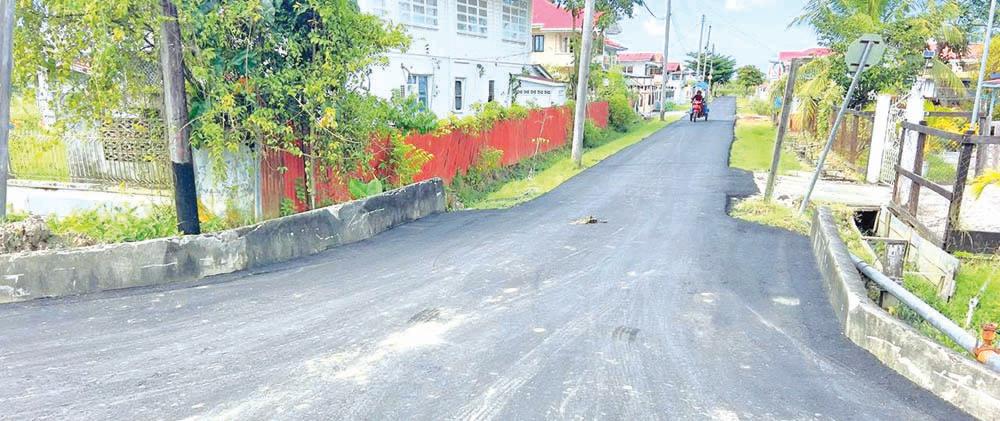
In keeping with government’s ongoing drive for better living standards across the country, Region 6 (East Berbice-Corentyne) continues its development with new roads, water and electricity, along with a healthcare education facili-
the recent communities that will soon be connected to the national electricity grid.
Works have already begun with the installation of utility poles, which will be followed by the laying of electrical wires and final connections.
provided with potable water, and the introduction of electricity marks another step toward improving the quality of life for residents.
In addition, Reliance, East Canje, Berbice residents now benefit from enhanced infrastructure fol-
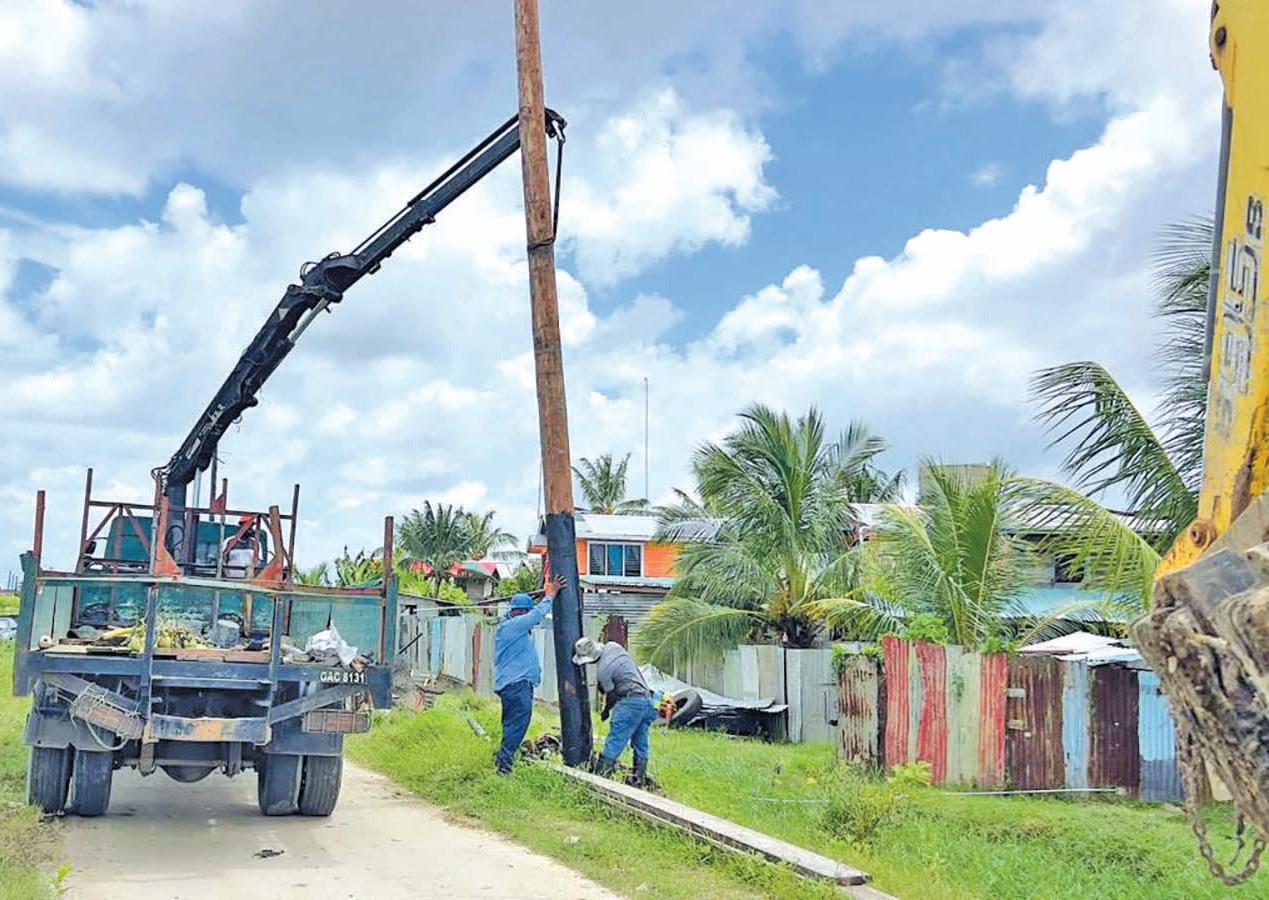
ty.
Residents in Tannery, New Amsterdam are among
Tannery, a small community with fewer than 20 homes, was also recently
lowing the rehabilitation of two key streets in the village, already providing bet-
The Government of Guyana is pleased to announce that an Emancipation Day Observance Event will take place on Thursday, July 31, 2025, from 6:00pm to 8:00pm at the Medgar Evers College, Edison O. Jackson Auditorium in Brooklyn, New York.
This event will be hosted by the Consulate General of the Co-operative Republic of Guyana and will feature esteemed guest speaker, Professor John Edward Greene, Chancellor of the University of Guyana.
The program will also include keynote remarks from Ambassador Carolyn Rodrigues-Birkett, Guyana’s Permanent Representative to the United Nations, Ambassador Michael E. Brotherson, Consul General of Guyana to New York, and other distinguished officials.
Emancipation Day is an important occasion that honours the abolition of slavery and pays homage to the strength, resilience, and sacrifices of our African ancestors. Their enduring spirit paved the way for many of Guyana’s cultural and political achievements.
This event will encourage reflection on
our shared history and reaffirm our collective responsibility to the values of freedom, justice and dignity, principles that remain central to Guyana’s development and prosperity.
This year’s event will feature vibrant cultural performances, a Libation ceremony, authentic Guyanese and African cuisine, dances, and artistic expressions that celebrate the African influence on Guyanese society, all reflecting the diversity that defines us as Guyanese and highlighting our commitment to national unity.
All members of the Guyanese diaspora in New York and beyond are invited to attend this meaningful occasion. The diaspora, particularly in New York remains a crucial player in shaping an inclusive future for all Guyanese.
The diaspora’s continued cultural and economic contributions are crucial to Guyana’s global presence and development trajectory, and the Government of Guyana is committed to ensuring full participation of each Guyanese.
The Guyana Consulate in New York can be contacted for further information.
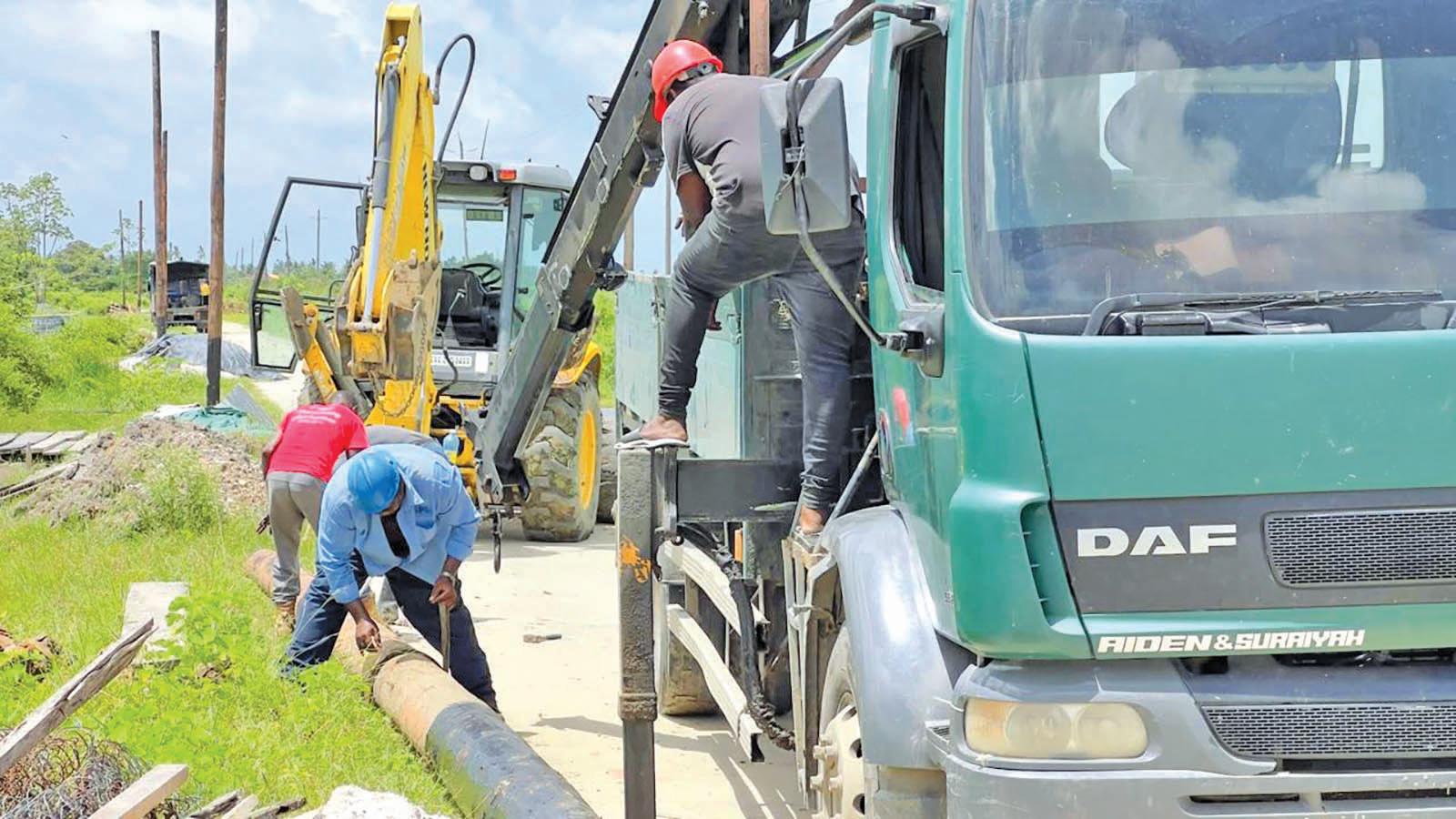
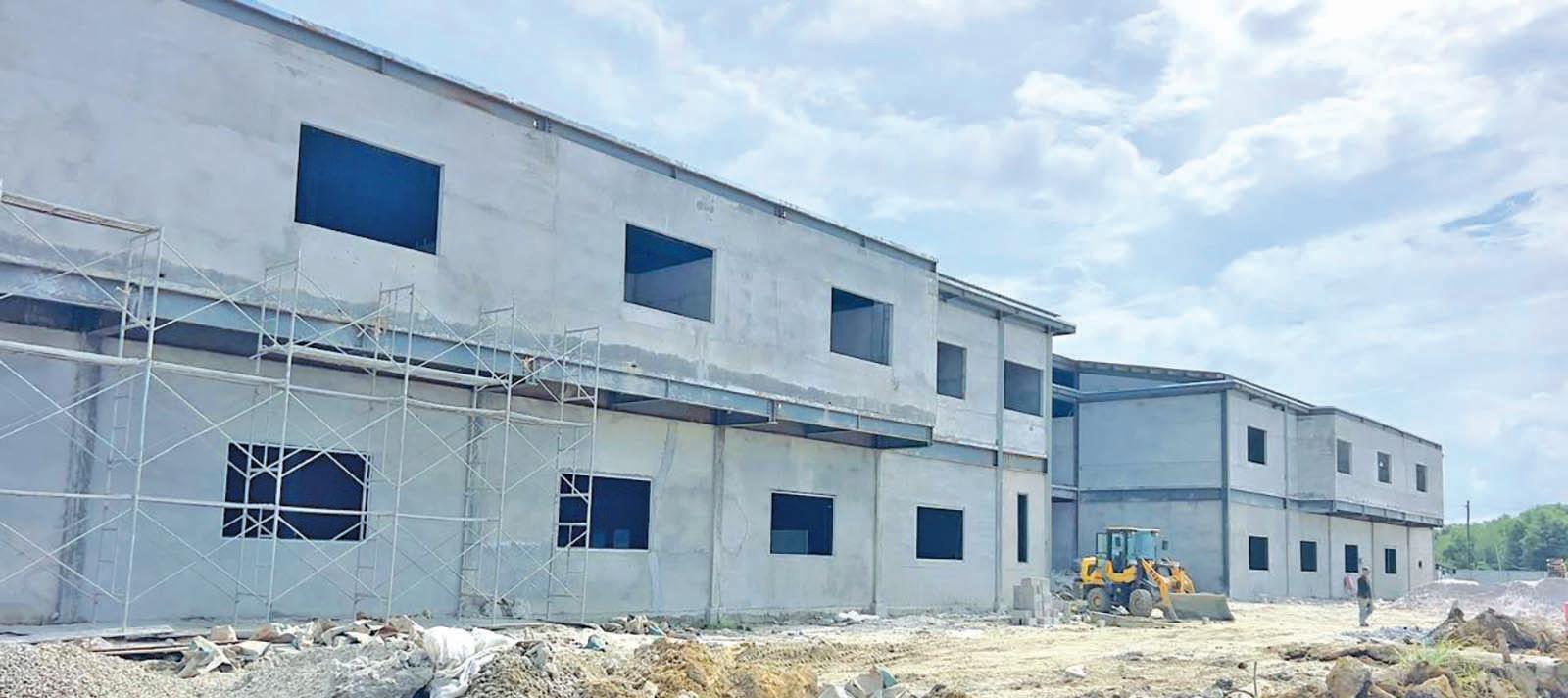
ter connectivity and accessibility for villagers. Roadworks are also ongoing in the Belvedere Housing Scheme, Corentyne, while upgraded solar systems improve services at the Schepmoed Health Centre, on the East Bank Berbice.
Meanwhile, construction of a modern training school to help meet the growing demand for health workers and strengthen Guyana’s healthcare system is moving apace at Main and Charles
Place, New Amsterdam. The new health training school will offer more than 20 accredited programmes when completed. The programmes are expected to include fields such as nursing, lab technology and imaging.


The Inter-American Development Bank (IDB) has approved a US$30 million Conditional Credit Line for Investment Projects (CCLIP) to aid in Guyana’s efforts to enhance its water and sanitation infrastructure.
According to the IDB, CCLIP aims to enhance the resilience, quality and sustainability of the services provided by Guyana Water Incorporated (GWI), including drinking water and sewerage services.
Approximately 151,560 people will benefit from improved access to safe and reliable water services.
With the IDB credit line, Guyana can continue its effort to upgrade and transform the potable water supply sector. It is said that GWI will also undergo a digital transformation, enabling the adoption of modern technologies and tools to improve operation -
al management, reduce costs and increase revenue.
Additionally, the main objective of the investment includes the construction of a new water treatment plant at Diamond, along with approximately 15 kilometres (km) of transmission pipelines and interconnections to facilitate the integration of the new plant with existing distribution networks.
With the programme’s support for reducing non-revenue water initiatives, work will be undertaken to advance Guyana’s leak detection and repair efforts, along with public awareness campaigns. Meanwhile, enhancements are underway across the East Bank of Demerara (EBD), East Coast Demerara (ECD) and Cummings Lodge systems, with the integration of management information systems, improved metering and increased operational efficiency.
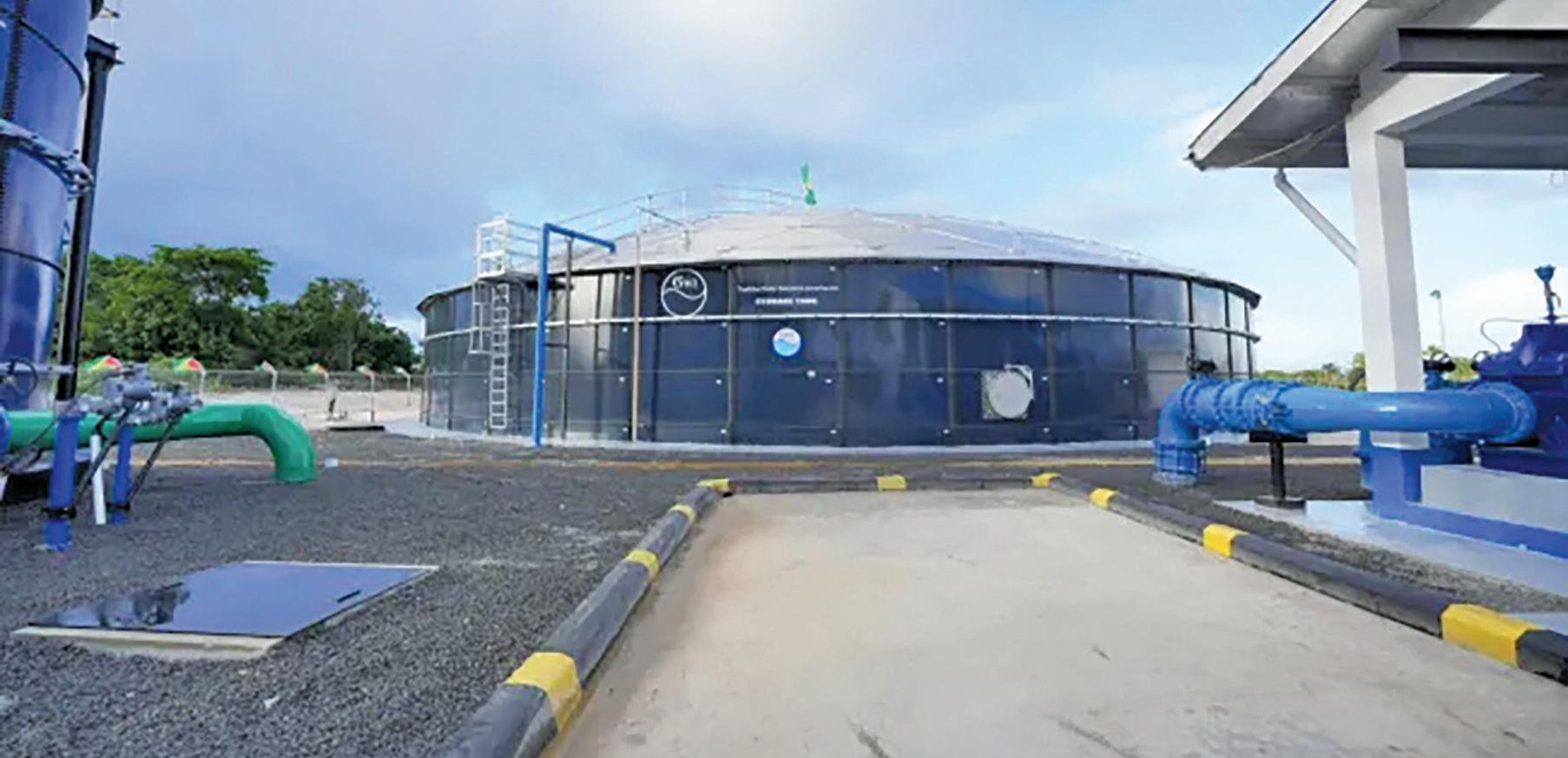
The IDB also approved a Specific Investment Loan (ESP) of US$15.57 million to improve the water and sanitation infrastructure in Guyana.
Aiding the Government’s push for potable water nationwide, a 38 per cent increase was seen in 2020 and over
90 per cent in 2025, with the primary objective of achieving 100 per cent potable water coverage by year-end.
In addition, the US$30 million CCLIP has a repayment term of 25 years, a 5.5-year grace period and an interest rate based on the Secured Overnight
Financing Rate (SOFR), and will also benefit from a co-financing contribution of US$36.33 million to be financed by the Japan International Cooperation Agency (JICA). Over the past five years, Guyana has embarked on a transformative journey in the water and sanitation
sector to increase potable water supply by constructing new water treatment plants, installing transmission mains to improve the quality of service to citizens nationwide, and drilling new wells in both coastal and hinterland communities to extend access to safe water supply.
Paramakatoi airstrip also set for
The Amerindian village of Karisparu in Region Eight has received a $314.4 million upgrade to the community’s airstrip.
According to a Department of Public Information (DPI) report, the investment transformed the once uneven, sand-gravel runway, which was prone to water-logging during heavy rainfall and poor aircraft performance in dry conditions, into a fully functional concrete surface. The Ministry of Public Works said that the upgraded airstrip retains its original alignment and now measures 720 metres in length and 15.24 metres in width, featuring a 125mm thick concrete surface, along with a 30-metre by 30-metre aircraft apron. The apron is a vital component of the airstrip, which provides an area for
an aircraft to be serviced or readied for subsequent flights.
The key elements of the rehabilitation work include topographic and engineering surveys, the application of a 150mm sand-gravel levelling course, followed by a 150mm sand-gravel base course, and finally the placement of the 125mm concrete surface.
Ideal Engineering Services finished these works by the June 4, 2025 deadline.
This major upgrade will provide improved connectivity for hundreds of residents, lowering travel costs and boosting economic development. It will also increase tourism in the area, boosting the economy by highlighting its beautiful scenery, mountains, waterfalls and diverse attractions.
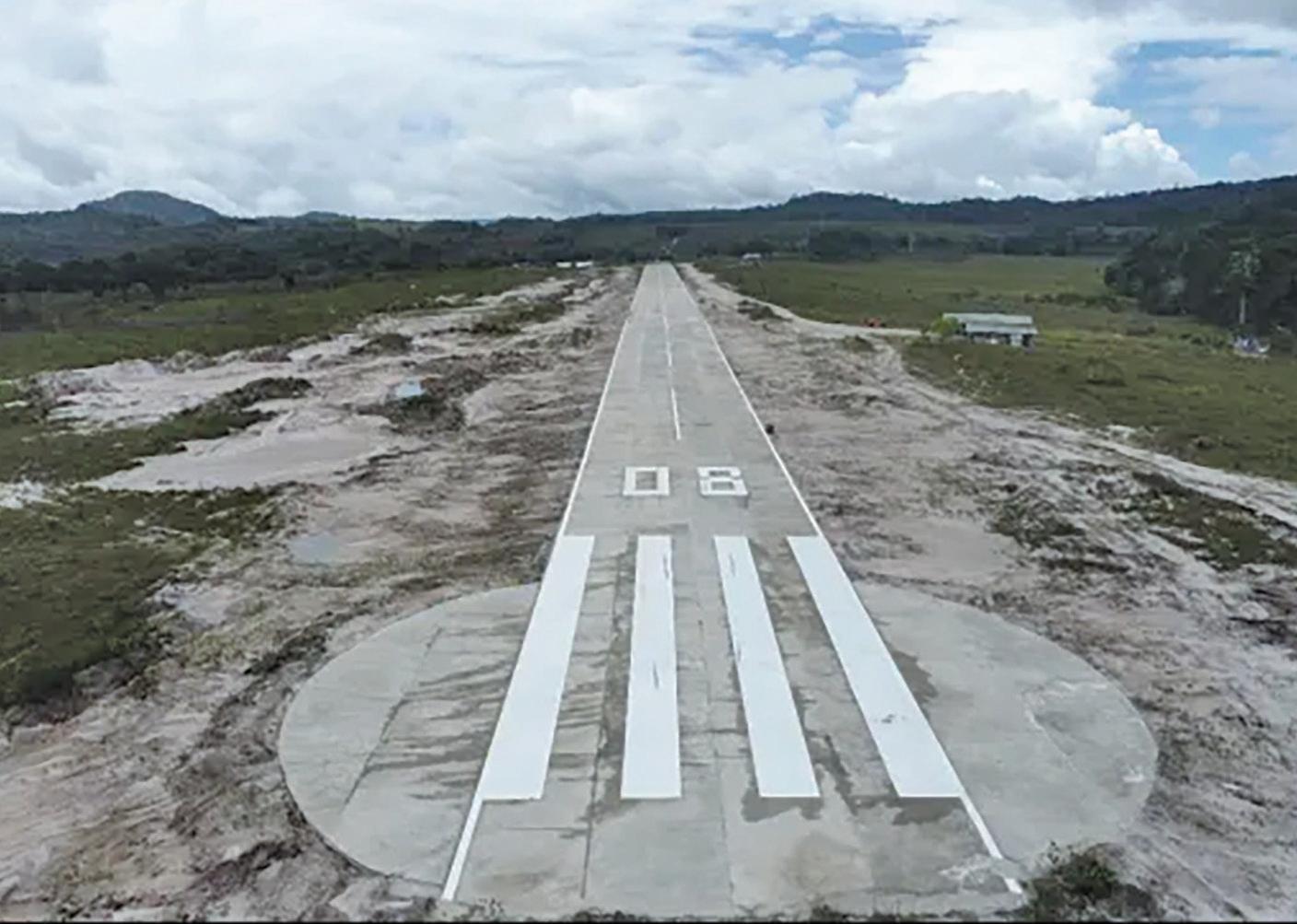
The newly-upgraded Karisparu airstrip
Moreover, this investment by the Government forms part of a broader effort to improve connectivi -
ty and access in hinterland communities. Similarly, air travel to the neighbouring commu -
nity of Paramakatoi will also become easier, as the Government injected $799 million for the reconstruc -
tion of its airstrip. The upgraded airstrip will span 2,500 feet in length and 50 feet in width.
The structure will be fortified using six inches of rigid paved concrete, BRC mesh and steel joints to ensure durability and efficient load transfer between slabs.
In addition to the main runway, a 100×100 feet tarmac will serve as a designated parking area for aircraft. When completed, the airstrip is expected to improve air connectivity and safety in the North Pakaraimas, offering enhanced access for emergency and regular flights. These airstrips are not stand-alone projects, as the Government has allocated $2.5 billion for the development of hinterland airstrips.




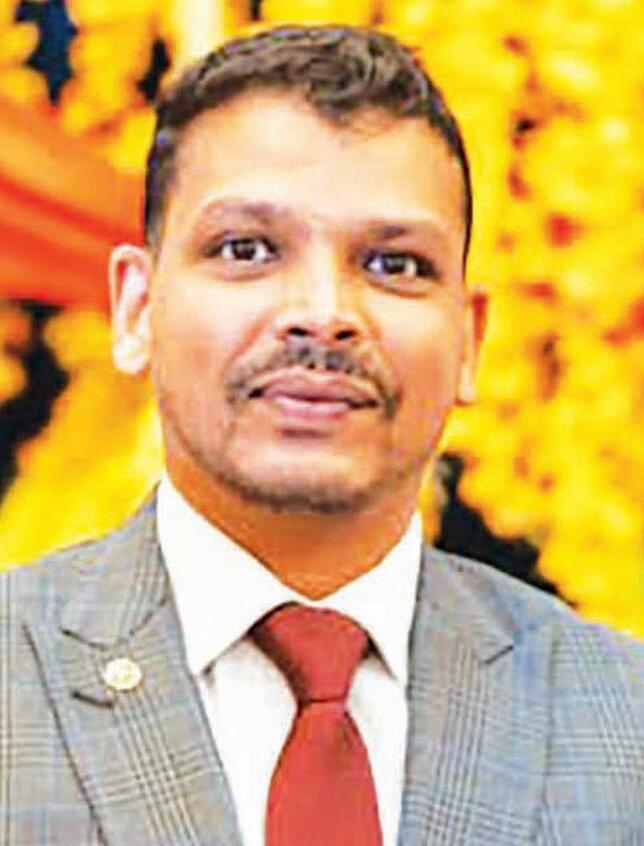
Dr Tariq Jagnarine Fam meD, enDocrinology/ DiabeTes
Hepatitis is an inflammation of the liver. It may be caused by viral infection, alcohol consumption, several health conditions, or even some medications. Treatment varies based on the type and underlying cause.
Hepatitis refers to the inflammatory condition of the liver. It is commonly the result of a viral infection, but there are other possible causes of hepatitis. These include autoimmune hepatitis and hepatitis that occurs as a secondary result of medications, drugs, toxins, and alcohol. Autoimmune hepatitis is a disease that occurs when your body makes antibodies against your liver tissue.
The five main viral classifications of hepatitis are hepatitis A, B, C, D, and E. A different virus is responsible for each type of viral hepatitis.
The World Health Organisation (WHO) estimates that 354 million people currently live with chronic hepatitis B and C globally.
• Hepatitis A
Hepatitis A is the result of an infection with the hepatitis A virus (HAV). This type of hepatitis is an acute, short-term disease.
• Hepatitis B
The hepatitis B virus (HBV) causes hepatitis B. This is often an ongoing, chronic condition. The Centers for Disease Control and Prevention (CDC) estimates that around 826,000 people are living with chronic hepatitis B in the United
States and around 257 million people worldwide.
• Hepatitis C
Hepatitis C comes from the hepatitis C virus (HCV). HCV is among the most common bloodborne viral infections in the United States and typically presents as a long-term condition. According to the CDC, approximately 2.4 million Americans are currently living with a chronic form of this infection.
• Hepatitis D
This is a rare form of hepatitis that only occurs in conjunction with hepatitis B infection. The hepatitis D virus (HDV) causes liver inflammation like other strains, but a person cannot contract HDV without an existing hepatitis B infection. Globally, HDV affects almost five per cent of people with chronic hepatitis B.
• Hepatitis E
Hepatitis E is a waterborne disease that results from exposure to the hepatitis E virus (HEV). Hepatitis E is mainly found in areas with poor sanitation and typically results from ingesting faecal matter that contaminates the water supply. This disease is uncommon in the United States, according to the CDC.
Hepatitis E is usually acute, but can be particularly dangerous in pregnant women.
cause permanent damage and lead to thickening or scarring of liver tissue (cirrhosis) and liver failure.
Other toxic causes of hepatitis include misuse of medications and exposure to toxins.
• Autoimmune system response
In some cases, the immune system mistakes the liver as harmful and attacks it. This causes ongoing inflammation that can range from mild to severe, often hindering liver function. It’s three times more common in women than in men.
• COMMON SYMPTOMS OF HEPATITIS
If you are living with a chronic form of hepatitis, like hepatitis B and C, you may not show symptoms until the damage affects liver function. By contrast, people with acute hepatitis may be present with symptoms shortly after contracting a hepatitis virus. Common symptoms of infectious hepatitis include: Fatigue
Flu-like symptoms
Dark urine Pale stool
Abdominal pain
Loss of appetite
Unexplained weight loss
Yellow skin and eyes, which may be signs of jaundice
DIAGNOSIS
Type of hepatitis Common Route of Transmission
Hepatitis A exposure to HAV in food or water

pain or tenderness. Your doctor may also check for any swelling of the liver and any yellow discoloration in your eyes or skin.
• Liver function tests
Liver function tests use blood samples to determine how efficiently your liver works.

abdomen. This test allows your doctor to take a close look at your liver and nearby organs. Sometimes the pancreas shows up on ultrasound images as well. This can be a useful test in determining the cause of your abnormal liver function.
chiatric conditions, and people with autoimmune diseases.
Hepatitis E
Currently, no specific medical therapies are available to treat hepatitis E. Because the infection is often acute, it typically resolves on its own. Doctors will typically advise people
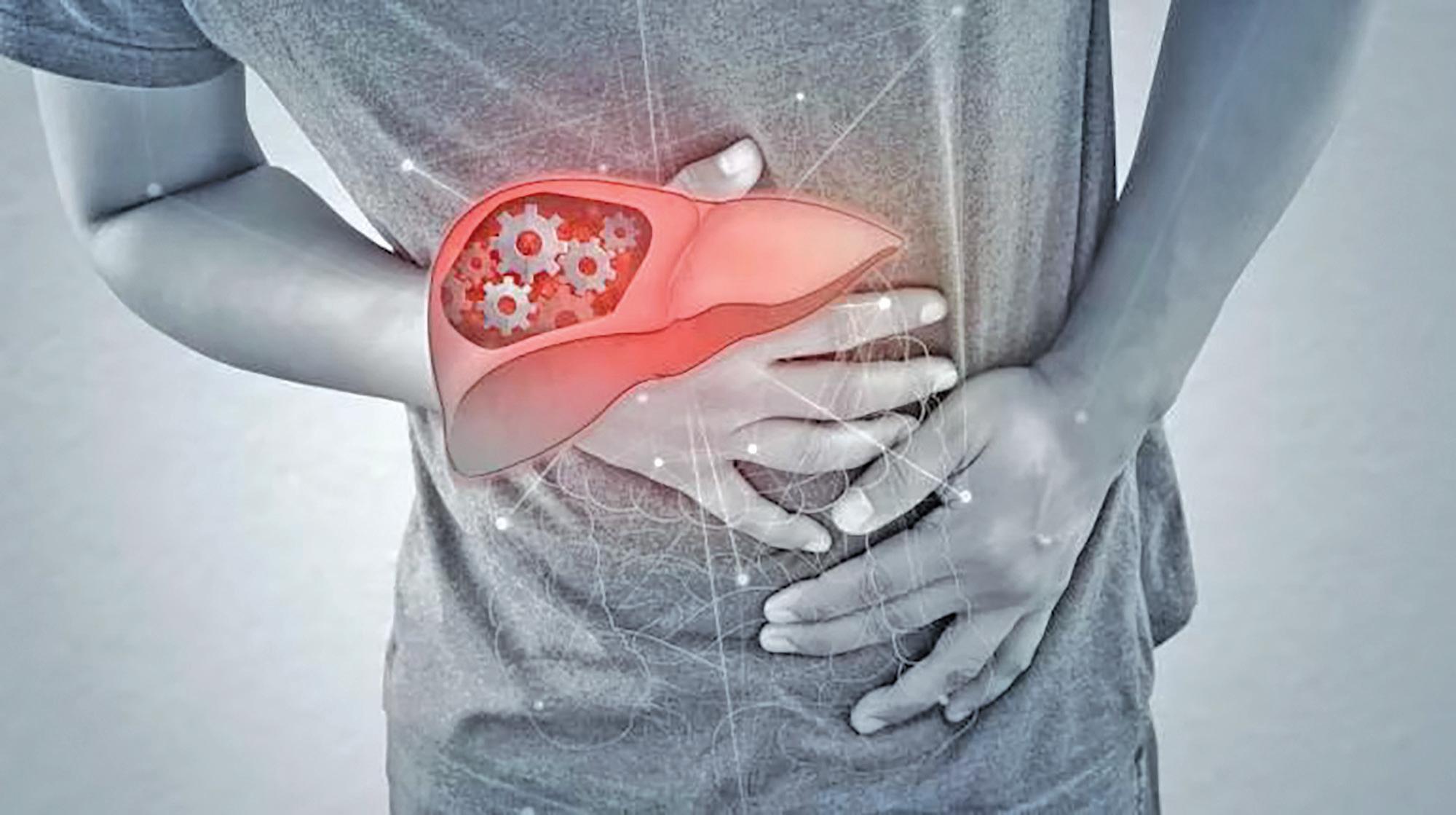
Abnormal results of these tests may be the first indication that there is a problem, especially if you don’t show any signs on a physical exam of liver disease. High liver enzyme levels may indicate that your liver is stressed, damaged, or not functioning correctly.
• Other blood tests
If your liver function tests are abnormal, your doctor will likely order other blood tests to detect
Hepatitis B contact with HBV in body fluids, such as blood, vaginal secretions, or semen
Hepatitis C contact with HCV in body fluids, such as blood, vaginal secretions, or semen
Hepatitis D contact with blood containing HDV
Hepatitis E exposure to HEV in food or water
CAUSES OF NONINFECTIOUS HEPATITIS
Although hepatitis is most commonly the result of an infection, other factors can cause the condition.
• Alcohol and other toxins
Excess alcohol consumption can cause liver damage and inflammation. This may also be referred to as alcoholic hepatitis. Alcohol directly injures the cells of your liver. Over time, it can
It is crucial to understand what is causing hepatitis to treat it correctly. Doctors will progress through a series of tests to accurately diagnose your condition.
To diagnose all forms of hepatitis, your doctor will first take your history to determine any risk factors you may have.
During a physical examination, your doctor may press down gently on your abdomen to see if there’s

the source of the problem. These tests can determine if you have infectious hepatitis by checking for the presence of hepatitis viruses or antibodies your body produces to combat them. Doctors may also use blood tests to check for any signs of autoimmune hepatitis.
• Liver biopsy
When diagnosing hepatitis, doctors will also assess your liver for potential damage. A liver biopsy is a procedure that involves taking a sample of tissue from your liver. A medical professional may take this sample through your skin with a needle, meaning there is no need for surgery. They will typically use an ultrasound scan for guidance during this procedure. This test allows your doctor to determine how infection or inflammation has affected your liver.
• Ultrasound
An abdominal ultrasound uses ultrasound waves to create an image of the organs within your
Treatment options will vary by the type of hepatitis you have and whether the infection is acute or chronic.
Hepatitis A
Hepatitis A is a shortterm illness and may not require treatment. However, if symptoms cause a great deal of discomfort, bed rest may be necessary. In addition, if people experience vomiting or diarrhoea, a doctor may recommend a dietary programme to maintain their hydration and nutrition.
Hepatitis B
There is no specific treatment programme for acute hepatitis B. However, if you have chronic hepatitis B, you will require antiviral medications. This form of treatment can be costly, as you may have to continue it for several months or years.
Treatment for chronic hepatitis B also requires regular medical evaluations and monitoring to determine if the virus is responding to treatment.
Hepatitis C
Antiviral medications can treat both acute and chronic forms of hepatitis C. Typically, people who develop chronic hepatitis C will use a combination of antiviral drug therapies. They may also need further testing to determine the best form of treatment. People who develop cirrhosis or liver disease due to chronic hepatitis C may be candidates for a liver transplant.
Hepatitis D
The WHO lists pegylated interferon alpha as a treatment for hepatitis D. However, this medication can have severe side effects. As a result, it’s not recommended for people with liver cirrhosis, those with psy-
with this infection to get adequate rest, drink plenty of fluids, get enough nutrients, and avoid alcohol. However, pregnant women who develop this infection require close monitoring and care.
Autoimmune hepatitis
Corticosteroids, like prednisone or budesonide, are extremely important in the early treatment of autoimmune hepatitis. They’re effective in about 80 per cent of people with this condition.
Azathioprine (Imuran), a drug that suppresses the immune system, may also be a part of treatment programmes. People may use this with or without steroids.
PREVENTION
Some vaccines can help protect against many hepatitis viruses. Minimising your risk of exposure to substances containing these viruses can also be an important preventive measure.
• Vaccines
• Reducing exposure
• Practising effective hygiene is one way to avoid contracting hepatitis A and E.
• You can reduce your risk of meeting fluids containing these viruses by:
o Not sharing needles
o Not sharing razors
o Not using someone else’s toothbrush
o Not touching spilled blood
Hepatitis B and C can be transmitted through sexual intercourse and sexual contact. Using barrier methods, such as condoms and dental dams, during sexual activity can help decrease the risk of infection.
Bahamas Police are investigating a viral video that showed a disabled man being dragged across a street by plainclothes officers, who are believed to be immigration authorities.
The incident occurred shortly after 43-year-old Jarvin Green, who uses a wheelchair, was ordered released from custody by Supreme Court Justice Dale Fitzpatrick.
The judge ruled the Jamaican man’s continued detention was unlawful after a February 10 deportation order had expired. The ruling followed a habeas corpus application filed by Green’s legal team.
Martin A Lundy II, who represents Green, told The Tribune: “Mr Green’s detention is not in issue here.
Fundamental rights and freedoms are owed to everyone in this country, even Lucifer himself.”
The attorney called the act a violation of basic human rights.
Mr Green had reportedly been held at the Carmichael Road Detention Centre since completing an eightyear sentence for causing dangerous harm. In 2018, prosecutors alleged he struck a man with a van after an argument involving
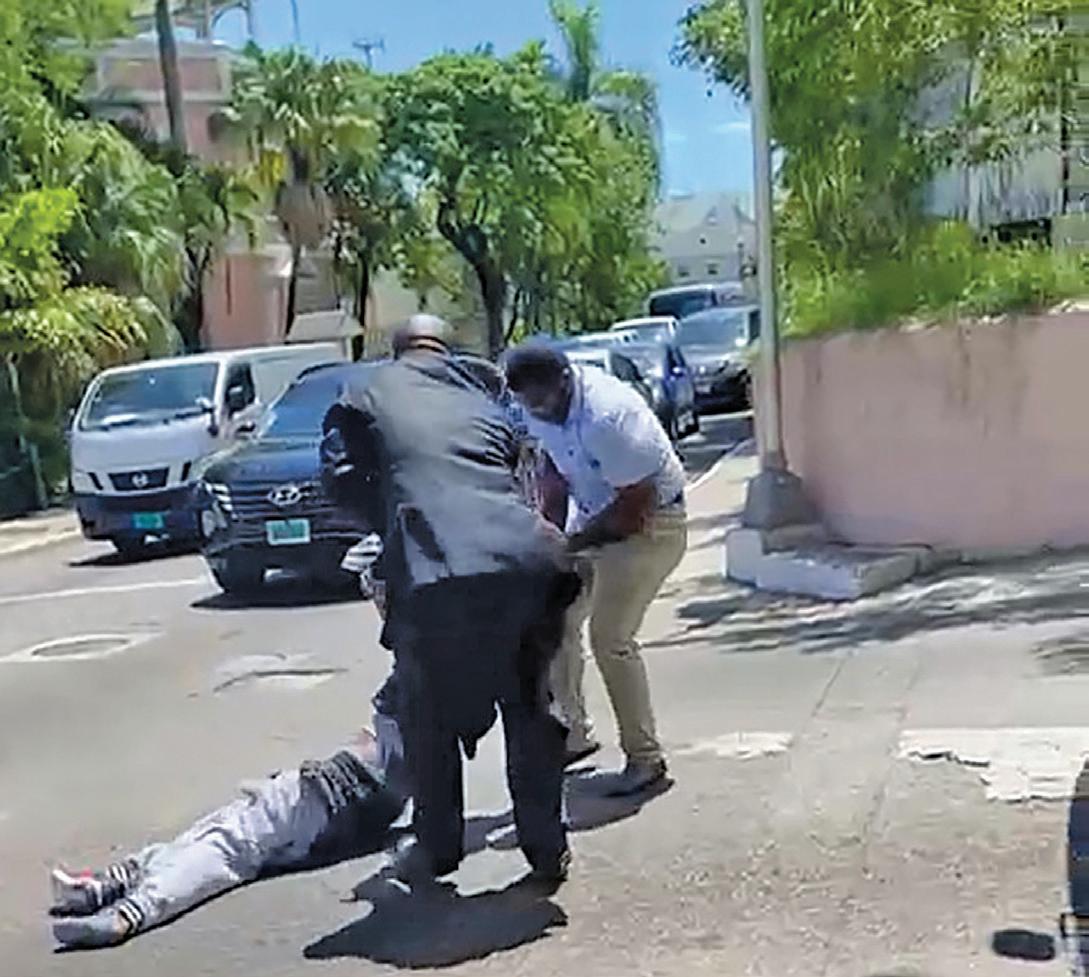
the victim’s niece. Mr Green maintained the seven-year sentence was unjust and criticised the justice system as “wicked”.
Though released in February and scheduled for deportation, Mr Green remained in detention past the 90-day legal limit.
The viral video and an accompanying audio clip, reportedly from a female eyewitness, surfaced just hours after the court ordered his release on July 23.
Mr Lundy acknowledged that immigration officials have legal authority to re-detain individuals under
certain conditions, but said nothing justified the physical treatment his client received.
He also raised longstanding concerns about Mr Green’s prior incarceration.
Mr Green, he said, entered prison in 2006 walking and left permanently disabled.
“What happened to Mr Green while he was in custody of the Department of Corrections?” he asked.
When contacted by The Tribune, acting Immigration Director William Pratt declined to comment on the matter. (Excerpt from The Tribune)
The Argentina Milei administration has expelled its first immigrant as part of its controversial executive order 366/25. Juan Pedro Martinez Piedraita, a 60-year-old AfroUruguayan and father of two, had been living in the country for 19 years.
According to Diego Morales, who leads the litigation and legal defense team at the Center for Legal and Social Studies (CELS, by its Spanish acronym), Martinez Piedraita was detained on Friday at the National Directorate of Migration (DNM), where he had gone to renew his status as a temporary resident.
In 2021, Martinez Piedraita had received a suspended sentence of 18 months for crimes related to threats and disobedience. That sentence had elapsed when Martinez Piedraita applied for a national identification card, also known as a DNI.
DNM ultimately elected to deport him on the grounds that he was in violation of an article of the Immigration Law that prohibits those with criminal re-

cords from remaining in the country. But this article only applies to those whose crimes earned sentences of three years or longer. What’s more, Martinez Piedraita’s children are Argentine, which makes him eligible for permanent residence.
The Uruguayan native was transferred to the Federal Police, with whom he remained until Wednesday morning. At 3:00 AM, he was taken to Uruguay aboard a Buquebus, a ferry that makes regular trips between the two countries across the Rio de la Plata.
“We were made aware
of this case today, when Piedraita’s attorney, Zulema Montero, informed us that she had told the judge who ordered his detention that he was the father of Argentine children, that he had completed his suspended sentence, and that the sentence was for less than three years,” Morales told the Herald.
“They deported him anyway.”
“Our concern is that expulsions could be carried out without a legal basis, to say nothing of the family separation involved,” he added.
“Beyond the legal ramifications in Argentina, this could also create a diplomatic dispute with Uruguay.”
Milei’s executive order, which mirrors the nativism of other far-right governments, including Trump’s, has fundamentally altered what had been one of the region’s most open and inclusive immigration policies.
Executive order 366/25 makes deportations easier, restricts migrants' access to health and education, and adds more requirements for foreigners obtaining Argentine citizenship or permanent residency. (Source: Buenos Aires Herald)

Missionary groups are using audio devices in protected territories of the rainforest to attract and evangelise isolated or recently contacted Indigenous people in the Amazon.
A joint investigation by the Guardian and Brazilian newspaper O Globo reveals that solar-powered devices reciting biblical messages in Portuguese and Spanish have appeared among members of the Korubo people in the Javari valley, near the Brazil-Peru border.
Drones have also been spotted by Brazilian state agents in charge of protecting the areas. The gadgets have raised concerns about illegal missionary activities, despite strict government measures designed to safeguard isolated Indigenous groups.
This is not thought to be the first recent attempt by missionary groups to reach isolated and uncontacted communities in the Javari valley.
Now it has emerged that missionaries have returned to the Javari valley and surrounding towns, such as

Atalaia do Norte, with a new tool.
The first device uncovered, a yellow and grey mobile phone-sized unit, mysteriously appeared in a Korubo village in the Javari valley recently.
The gadget, which recites the Bible and inspirational talks by an American Baptist, can do so indefinitely, even off-grid, thanks to a solar panel. Up to seven of the units were reported by local people, but photo and video evidence were obtained for just one.
The Brazilian government does not permit proselytising in the Korubo’s territory. Its policy, dating from 1987, stipulates that isolated groups must initiate any contact, a stance that made Brazil a pioneer in respecting Indigenous self-determination. The state also strictly controls access, to protect the Korubo and other uncontacted peoples in the region from common diseases to which they have little or no immunity. (Excerpt from The Guardian)
Ecuador's Interior Ministry announced Saturday that it will deport 1,000 Colombian prisoners to that country. The process has begun with 700 inmates held in various Ecuadorian prisons, and Colombia denounced the process as being carried out in a "unilateral" and "unfriendly" manner.
"This action reaffirms the Ecuadorian State's commitment to internal security and public order," the Ecuador Ministry of State stated in a statement, after Colombia confirmed hours earlier that it had already received nearly 450 people at the border.
According to the Ministry of the Interior, nearly 1,000 individualized hearings were held this month for
Colombian prisoners, as part of an administrative deportation process based on a ministerial agreement signed on July 2.
The National Service for Comprehensive Care of Adults Deprived of Liberty (SNAI), the state institution that administers and oversees prisons, arranged for the inmates to be brought before the judges, and within 24 hours, the judges received the administrative deportation resolution and issued the release orders.
The process of completing the 1,000 deportees will continue until Wednesday.
On Friday night, the Colombian Foreign Ministry expressed "its strongest protest" against Ecuador for unilaterally beginning the deportation of Colombian
prisoners in Ecuadorian jails, and denounced that this had prevented the development of a dignified transfer protocol.
The Ecuadorian Foreign Ministry maintained that it "officially notified the Colombian Consulate in Quito on July 8 about the individual deportation proceedings underway, acting through diplomatic channels."
Unlike other prisoner repatriations, where prisoners were expected to continue serving their sentences in Colombia, the prisoners expelled by Ecuador were exonerated and regained their freedom upon entering Colombian territory if they do not have pending legal proceedings in that country. (Excerpt from El Deber)
With Mexican cattle again barred this month from entry to the United States over fears of spreading a flesh-eating parasite, ranchers and veterinarians in Mexico hundreds of miles from the border are fighting what has U.S. agricultural authorities so on edge.
In the southern state of Chiapas, which borders Guatemala, the New
World screwworm fly's rapid spread appears to have caught most ranchers off guard, despite memories of previous outbreaks in the 1980s and 1990s.
Veterinarian Alfredo Chávez says he's seen cases multiply in his corner of the state over the past month. He's heard of dozens of cases in the area now and treated about a dozen himself. It's not just cows ei -
ther — sheep, pigs, cats and dogs are targets as well.
Mexico is building a plant with U.S. support in Chiapas to produce sterile flies, which have proven effective at stopping the spread, but it won't be ready until next year. Meanwhile, the price of medicines used to treat livestock infected with the screwworm have soared in price. (Excerpt from NPR)

Developments on Sunday threw into doubt Trump’s claims of an immediate push for a ceasefire. The Thai army said Cambodian soldiers opened fire starting in the early morning at a temple, a checkpoint and civilian residences.
An army statement said it “necessitated Thai military retaliation to protect Thai citizens and territory, employing long-range artillery to target Cambodian artillery and rocket launchers”.
Cambodia countered that Thailand was the first to attack in the early hours of Sunday morning. “These deliberate and coordinated acts of aggression occurred despite ongoing efforts led by President Donald Trump to broker a ceasefire,” said Cambodia’s defence ministry, adding that Trump’s efforts were “publicly and unequivocally supported” by Cambodia’s prime minister.
Thai and Cambodian leaders will meet in Malaysia on Monday for talks to end hostilities, a spokesperson for the Thai prime minister’s office
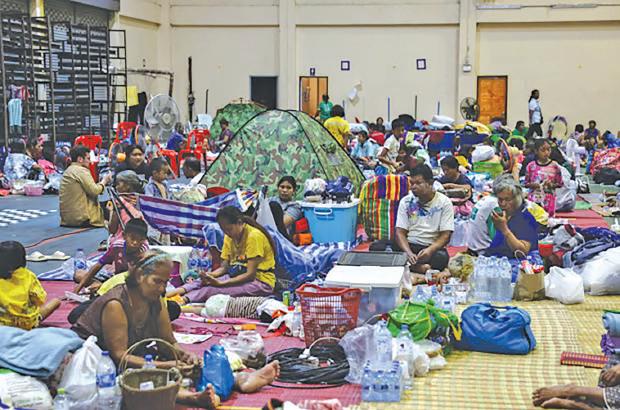
said, after pressure from the US president, Donald Trump, to end a deadly border dispute, now in its fourth day.
Jirayu Huangsap said the acting prime minister, Phumtham Wechayachai, would attend Monday’s talks in response to an invitation from the Malaysian prime minister, Anwar Ibrahim, “to discuss peace efforts in the region”.
The spokesperson said Phumtham’s Cambodian counterpart, Hun Manet, would also attend the talks, though this was not imme-
diately confirmed by the Cambodian side.
More than 150,000 people have been displaced by the clashes, which are the bloodiest between the neighbouring countries in more than a decade, and have claimed at least 10 lives in Thailand and 13 in Cambodia.
In social media posts, Trump said: “Both parties are looking for an immediate ceasefire and peace”, adding he would not negotiate a trade deal with either side until the fighting stopped. (Excerpt from The Guardian)
Israel on Sunday announced a halt in military operations for 10 hours a day in parts of Gaza and new aid corridors as Jordan and the United Arab Emirates airdropped supplies into the enclave, where images of starving Palestinians have alarmed the world.
Israel has been facing growing international criticism, which the government rejects, over the humanitarian crisis in Gaza, and indirect ceasefire talks in Doha between Israel and the Palestinian militant group Hamas have broken off with no deal in sight.
U.S. President Donald Trump, on a visit to Scotland, said Israel would have to make a decision on its next steps in Gaza, and he did not know what would happen after the collapse of ceasefire
and hostage-release negotiations with Hamas.
Military activity will stop from 10 a.m. to 8 p.m. (07001700 GMT) until further notice in Al-Mawasi, a designated humanitarian area along the coast, in central Deir al-Balah and in Gaza City, to the north.
The military said designated secure routes for convoys delivering food and medicine will also be in place between 6 a.m. and 11 p.m. starting from Sunday.
U.N. aid chief Tom Fletcher said staff would step up efforts to feed the hungry during the pauses in the fighting.
In their first airdrop in months, Jordan and the United Arab Emirates parachuted 25 tons of aid into Gaza on Sunday, a Jordanian official said, adding that those were not a substitute
for delivery by land.
Palestinian health officials in Gaza City said at least 10 people were injured by falling aid boxes.
Work on a UAE project to run a new pipeline that will supply water from a desalination facility in neighbouring Egypt to around 600,000 Gazans along the coast would also begin in a few days, the Israeli military said.
Dozens of Gazans have died of malnutrition in recent weeks, according to the Gaza Health Ministry in the Hamas-run enclave.
The ministry reported six new deaths over the past 24 hours due to malnutrition, bringing the total deaths from malnutrition and hunger since the war began in 2023 to 133, including 87 children. (Excerpt from Reuters)
At least one police officer was killed and 14 fighters detained after a gun battle erupted in Iraq’s capital with members of the Popular Mobilisation Forces (PMF), a state-sanctioned paramilitary umbrella that includes groups loyal to Iran.
The violence on Sunday broke out in Baghdad’s Karkh district when PMF fighters stormed a Ministry
of Agriculture building during the appointment of a new director, the Interior Ministry said.
The gunmen disrupted an official meeting, stirring panic among staff and an emergency police response team. Police responding to the scene “came under fire”, also resulting in injuries among security personnel.
The ministry said “it
The United States and European Union have reached a trade deal which will see a blanket tariff of 15% on all EU goods imported to the US
President Trump says the EU has promised hundreds of billions of dollars of investment and energy purchases
Trump and President of the European Commission
Ursula von der Leyen met for talks in Scotland on Sunday – she has called the agreement a “huge deal”
The new deal is set to kick in on Friday, and means the Europe will avoid threatened import charges of 30%
Italian Prime Minister Giorgia Meloni says it’s positive that the EU has reached a deal with the US, but needs to see the details, Italy’s Ansa news
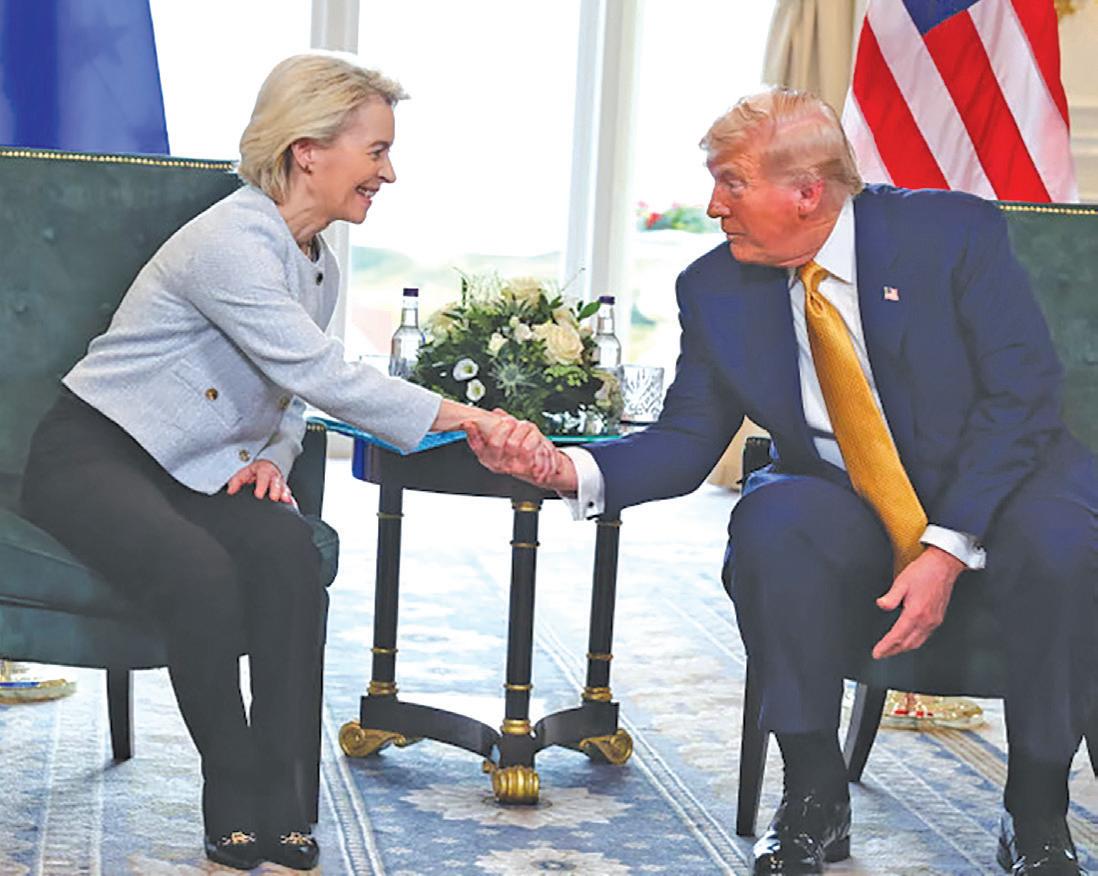
agency reports.
Italy is the EU’s third largest economy.
Trump said the EU will purchase $750bn in US energy, in addition to increasing overall investment in the US by $600bn.
The US president hailed the agreement as the “biggest deal ever made” and adds that Washington is eyeing up agreements with “three to four other countries”. (Excerpt from BBC News)
Thousands in Greece and Turkey evacuate as winds, heat fan wildfires
Thousands of people in Greece and Turkey have been forced to evacuate homes as firefighters in the countries battled to contain wildfires fanned by strong winds and searing heat.
As temperatures in south-eastern Europe exceeded 40C for a seventh straight day, the Greek prime minister praised rescue workers for waging “a titanic battle” to bring blazes under control.
Eleven regions of Greece face a “very high risk” of fire, and the government has appealed for help from EU partners to help it deal with fires burning on multiple fronts.
Emergency services said that while a conflagration that had injured two firefighters in Kryoneri, northeast of Athens, had been successfully quelled, fires around Messinia in the south-west Peloponnese and on the popular island of Kythera had not been contained.
The authorities were also battling flare-ups on the is-
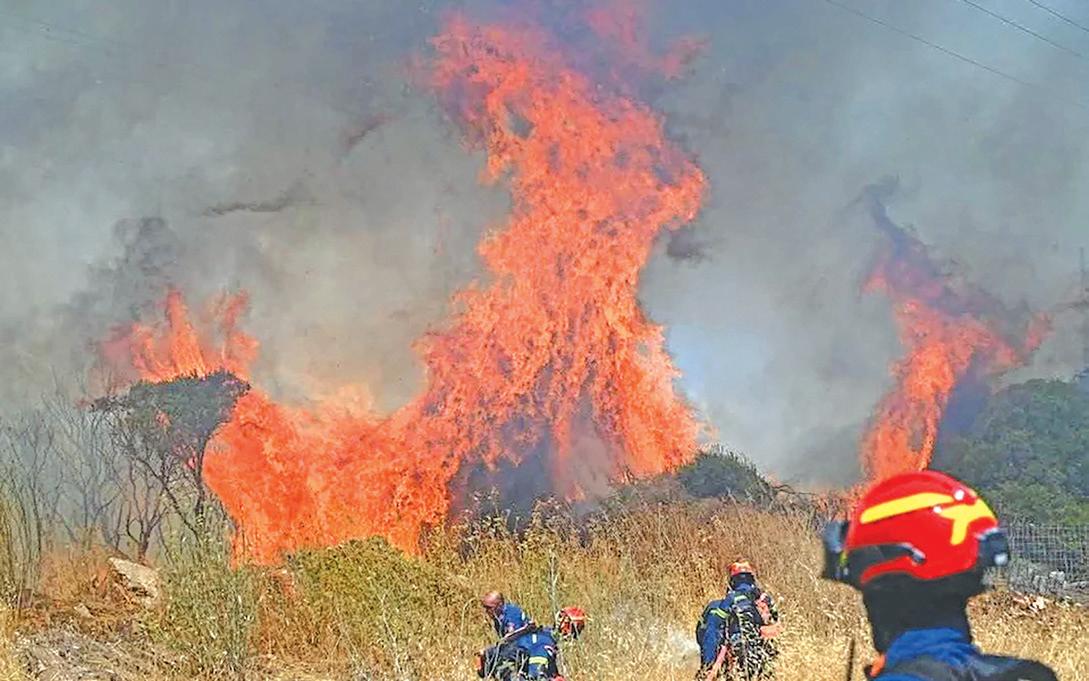
lands of Evia and Crete. In all of the stricken areas residents received messages to evacuate.
Several regions were placed under a red category 5 alert, the highest on the national scale, because of conditions exacerbated by the extreme weather that had turned terrain to tinder.
The National Observatory in Athens recorded a temperature of 45.8C (114.5F) in Messinia on Friday. On Saturday, the temperature reached 45.2C (113.4F) in Amfilochia, western Greece.
By late Sunday, as Czech firefighters and Italian water-bombers joined emergency teams in Greece, the focus turned to Kythera. Describing the destruction as “incalculable”, the public broadcaster ERT reported: “The first images are resonant of a biblical disaster as huge areas have been reduced to cinders and ash.” The island’s deputy mayor, Giorgos Komninos, was cited as saying: “Everything, from houses, beehives [to] olive trees has been burnt.” (Excerpt from The Guardian)
Twould not tolerate any party attempting to impose its will by force and threaten state institutions”.
Security sources and witnesses inside the building said the fighters aimed to block the replacement of the former director.
Hospital and police officials confirmed one officer was killed and nine others were wounded in the clash.
(Excerpt from Al Jazeera)
hirteen people were confirmed dead with dozens more missing after a boat ferrying around 100 passengers capsized on Saturday in Niger state in north-central Nigeria as they headed to market, authorities said on Sunday.
Twenty-six people, mostly women and children, were rescued from the wooden boat, said Yusuf Lemu, an official of the Niger State Emergency Management Agency.
Local official Isiyaku
Akilu said the boat driver, who was among those rescued, could not confirm the number of passengers on the boat. “The exact cause of the accident is yet to be determined, but from all indications, it appears to be due to overloading,” said Akilu.
Adamu Ahmad, a member of the boat drivers’ union, confirmed that the boat was overloaded. He said it was a large wooden boat and efforts are being made to recover more bodies.
Niger State is also home to
Nigeria’s three major hydroelectric dams, and boat accidents have become a frequent occurrence. Saturday’s accident happened nine months after a boat carrying mostly women and children returning from a religious festival capsized and killed at least 60 people. Rescue efforts were momentarily paused on Sunday to allow the custodian of the river to perform rituals that would ensure a “hitch-free rescue mission”, said Akilu. (Reuters)
















Take time to engage in talks and conduct research that will lead to better choices. Avoid restrictions that compromise your health or emotional well-being. Trust your instincts.
















Set high standards and make the changes necessary to achieve your goals. There is no place for anger or stubbornness. To succeed, you must first learn to get along with others.
A change of scenery will improve your attitude and feed your imagination. Networking and social events will lead to valuable information and introductions.
Dream big, but be realistic. Consider how to make your surroundings more convenient or clear a space to develop a moneymaking sideline. Start small and build from there.
Rise to any occasion and do your part. The way you approach achieving your goals will have an impact on your popularity. Put more thought into how you present yourself to others.
Keep your financial position to yourself. The less you share, the easier it will be for you to negotiate on your own behalf. Don't jeopardize your health or finances to accommodate someone else.
A change will become a revelation, encouraging you to broaden your vision while dismissing what's no longer working for you. Put your energy where it counts, and you will feel the difference.
Let your feelings and instincts guide you. You will surpass expectations if you act more than you speak. Learn as you go and elevate your game in real time.
Pay attention to your finances, health and home. Updating your look, getting in shape and socializing more will lead to interesting connections and insight into what to strive for next.


Listen, but don't believe everything you hear. Someone will be more intent on impressing you than on sticking to facts. Get the lowdown and avoid joint ventures.



Deal with issues regarding lifestyle, expenses or boundaries. Make a point of letting others know what you are willing to share and what's off-limits to those who venture into your world.

Evaluate situations before you get involved. Ask questions and consider the emotional ramifications your actions will have on your life and the lives of others. Take physical precautions to avoid injury or illness.


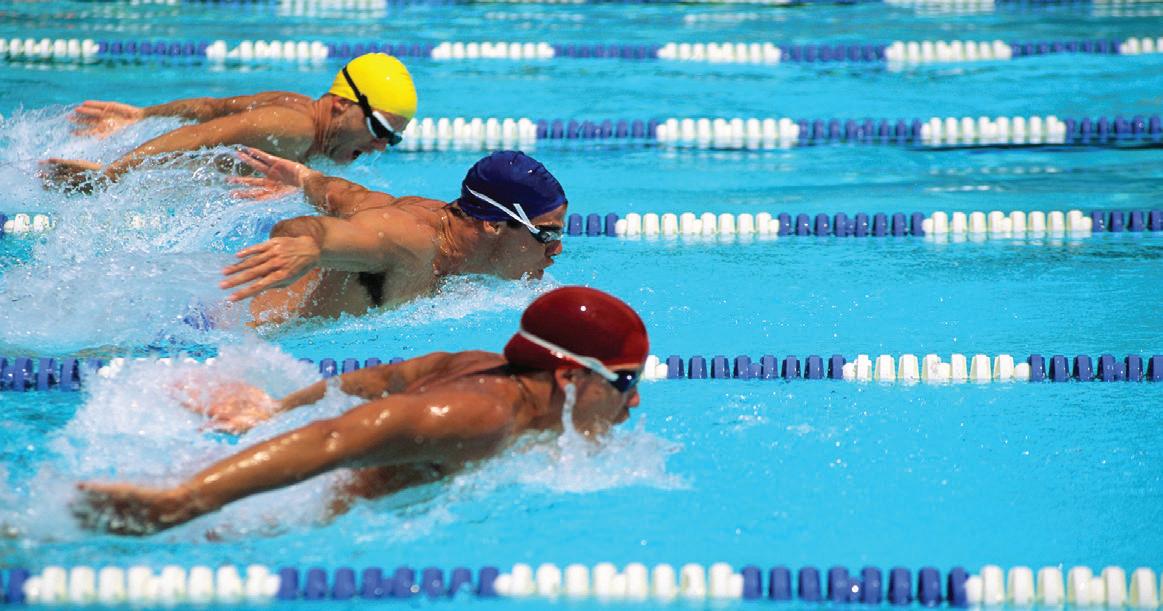



An epic series will be decided at The Oval.
England lead 2-1 after 20 tense days of Test cricket, but were denied a decisive win by five sessions of doughty, determined batting in which India lost only two wickets. Not even Ben Stokes, battling cramp and a shoulder injury, could pull this one off, and was forced to settle for only the second draw of his captaincy tenure.
India were 1 for 2 at lunch on the fourth day, frazzled after more than 150 overs in the field, and still trailing by over 300 runs. But Shubman Gill’s new-look side underlined their character with two mammoth, match-saving partnerships – Gill put on 188 with KL Rahul, and Washington Sundar and Ravindra Jadeja put on an unbroken 203 – to ensure India escaped with a draw.
They can no longer win the inaugural AndersonTendulkar Trophy, but will travel down to London today battered, bruised and bullish. India’s batters not only saved this match, but ground England’s bowlers down: they spent 257.1 overs in the field in Manchester, including 143
in the second innings, and now face a three-day turnaround before Thursday’s fifth Test.
The finale was farcical: Stokes offered a draw at the start of the last hour, but Gill had no interest, instead allowing his two all-round-
ters filled their boots.
“It’s going to happen in a flurry, lads,” Ben Duckett had promised his team-




Pant’s injury, and made his maiden Test hundred, while Jadeja capped his stellar series with the bat. Much as

ers to complete their centuries. England were incensed, serving up some 35 miles per hours lobs, but India’s players celebrated on the balcony as their bat-

mates during the second session. In fact, it never happened at all. It is long established that no Captain had ever won a Test match at Old Trafford after winning the toss and choosing to bowl; Stokes asked his team to defy history, but they could not.
It was Gill who had walked in to face a hattrick ball in the first over of India’s second innings shortly before lunch on the fourth day. When he walked back off just over 24 hours later, he had become only the third man to score four hundreds in a Test series as Captain, going past 700 runs for the tour. Every time he has reached 20, he has gone on to score a century.
He was supported by two marathon efforts from his spin-bowling all-rounders. Washington batted at number eight in the first innings, but was promoted to number five after Rishabh
it frustrated England, both players deserved centuries, and had earned the right to make them.
Stokes’ bowling fitness was uncertain overnight: he did not bowl at all on the fourth day after a heavy workload in the series – and a five-wicket haul in the first innings – having retired hurt during his century. But he shared the old ball with Liam Dawson early in the day and threatened to break the game open, creating two early chances in an eight-over spell.
He grimaced after every ball he bowled and repeatedly stretched out his right shoulder, but Stokes bowled with good pace and found variable bounce on a good length outside the righthanders’ off stump. He had Gill dropped early on, Ollie Pope failing to cling onto a stinger at short cover, but then trapped Rahul on the back pad to have him lbw for 90.
It was a brilliant spell, one which exposed just how much England had missed his bowling on the fourth evening. Stokes was in pain, then inflicted some on his opposite number: he found some steep bounce to strike Gill on the helmet –via the glove – with a lifter which exploded from a good length.
But Gill pressed on, steering Chris Woakes through the off side then yelping in celebration as he brought up his fourth century of the tour. His dismissal, edging Jofra Archer behind, represented an opening, not least when Jadeja edged his first ball to first slip. But Joe Root put the catch down, and England hardly created another chance all day.
Dawson wheeled away for 47 overs in the second innings and bowled tightly, but rarely threatened the edge, and the seamers had nothing to work with: Archer exchanged tense words with his captain over a field change, Woakes bowled slower balls into the
rough, Brydon Carse was hardly seen, and Stokes bowled only three overs after lunch. Jadeja and Washington had 89 and 80, respectively, when Stokes offered a draw, but Gill looked out steadfastly through the dressing-room window. It prompted Brook to bowl some filth, and both batters reached three figures off his bowling: Jadeja roared in celebration on reaching his by lofting a straight six, while Washington raised his arms aloft as he sauntered back for two. It made for a strange end to a compelling Test match. Only 24 wickets fell across the five days, and the finish was an anti-climax. But the fraying tempers were the result of India’s doughty resistance across five sessions of determined batting. It seemed unfathomable on Saturday afternoon, but they will head to The Oval believing that they can snatch a series draw. (ESPNcricinfo)
(Chris Woakes, 129.1 ov), 8-563 (Liam Dawson, 139.3 ov), 9-658 (Ben Stokes, 155.3 ov), 10669 (Brydon Carse, 157.1 ov)
Chase drive off Hardie.



Cameron Green’s fine form continues
Another composed unbeaten half-century from Cameron Green and some stunning hitting and catching from Glenn Maxwell helped Australia post a fourth straight win over a deflated West Indies in Basseterre.
Green made an unbeaten 55 from 35 to steer Australia home to a target of 206 with three wickets and four balls to spare following a middle-order collapse. The chase had earlier been set up by 51 off 30 from Josh Inglis while Player-of-theMatch Maxwell smashed 47 off 18 at the top of the order. Second-gamer Jediah Blades briefly threatened to be the hero with an outstanding spell of 3 for 29, but West Indies’ fielding once again let them down.
Australia, by contrast, were flawless in the field with Maxwell taking two catches and combining with Green to complete a stunning catch on the rope to back up an excellent bowling performance. With Ben Dwarshuis and Tim David
rested, Aaron Hardie and Xavier Bartlett grabbed their chance, taking 2 for 24 and 2 for 39 respectively, including three powerplay wickets to restrict
West Indies. Nathan Ellis was sensational again, bowling four overs for 21 runs while Adam Zampa and Sean Abbott also took five wickets between them.
West Indies became the first team in T20I history to score 200 without anyone scoring more than 34, with Sherfane Rutherford top-scoring with 31.
Bartlett and Hardie take powerplay wickets
As well as Australia have bowled in this series, they had only taken one powerplay wicket in the first three games. The selection of Bartlett and Hardie changed that. Both men had success with hard lengths rather than swing up front. Bartlett cramped both Brandon King and Shai Hope on consecutive deliveries in different overs while Hardie benefitted from Maxwell’s superb catching at mid-on. Having caught Hope diving forward on the circle, he casually stretched up with the one hand to pluck a Roston
Zampa 4-0-54-3 Nathan Ellis 4-0-21-0
Australia (T: 206 runs from 20 ovs) Mitchell Marsh (c) lbw b Blades 0
West Indies kept hitting despite the regular loss of wickets. Rutherford, Rovman Powell, and Shimron Hetmyer clubbed six sixes and seven fours between them. But none of them passed 31 as they all holed out with miscues.
Mitchell Owen continued Australia’s fine catching with a brilliant diving effort running in from deep backward point to remove Hetmyer. When Powell holed out to hand Hardie his second, West Indies were 119 for 6 after 11.1.


but he ended his innings with the same stunning act. Shepherd clubbed Zampa flat to longon and it looked to have easily cleared Maxwell. But he defied gravity and logic to jump as high as he could at full stretch to catch it with two hands and land on his left leg, which is still full of hardware from his fracture in 2022, before flicking it back to the waiting Green while momentum carried him over the rope. Maxwell’s two catches on the scorecard will be an unjust historical re-
swing first up and pinned Mitchell Marsh lbw second ball. Marsh’s decision not to review it despite ball-tracking showing it pitched outside leg might have been the

Mind-blowing Maxwell changes the game
Shepherd and Jason Holder were unperturbed by the scoreboard. Shepherd’s hitting showed he could well be used as a fullfledged all-rounder in this West Indies line-up. He mixed power and touch to maul Abbott. He lifted West Indies beyond 150 before the end of the 15th over, but his dismissal summed up the difference between the two sides.
Maxwell not only robbed Shepherd of a certain six,
cord of his contribution to the match.
Australia’s death bowling was superb again, conceding just 41 from the final five overs which took an additional 55 minutes to complete due to a long rain delay between Ellis’ second ball of the final over and his third.
Inglis and Maxwell cause déjà vu
There was a brief moment when West Indies’ fortunes defending a total might have taken a different turn. Blades found
luck West Indies needed.
Early swing for Blades and Holder saw a circumspect Australia score just 12 off the first two overs. But as soon as the swing disappeared, déjà vu set in. Inglis smashed seven boundaries in the next 11 balls. He added a four and a six off Matthew Forde’s first over of the series to raise a 50run stand with Maxwell who contributed one run. Inglis reached his 50 off 28 balls and ended up facing 29 balls in the powerplay before holing out to deep square off a full toss outside leg.

The lack of strike did not concern Maxwell nor did the field spreading outside the powerplay. He launched six sixes in typical Maxwell style, including three in three balls, to put Australia miles ahead of the required rate and briefly threatened to match David’s record for the fastest T20 International (T20I) fifty by an Australian less than 24 hours after it was set as Australia cruised to 129 for 2 after 10.
It’s the hope that kills you
A Maxwell miscue off Akeal Hosein sparked a collapse and gave West Indies a chance at victory. Blades loomed as the unlikely hero. He made Owen miscue to deep cover point and Cooper Connolly to mis-hit one to mid-off in the space of three balls. He then had Hardie dropped twice in two balls, with Shai Hope spilling a catch down the leg side before Blades failed to grasp a return offering himself.
But Green held his nerve to post his third half-century of the series. Every time West Indies bowlers threatened to close out a boundary-free over, he cleared the rope to ease the pressure. He reached his 50 off 30 balls with the required rate well under a run a ball despite Australia being six down. He offered a chance late with 11 to win, but Rutherford dropped a catch at deep midwicket to continue West Indies’ nightmare series. (ESPNcricinfo)


Guyana Defence Force Football Club (GDF FC), the reigning champions of the Guyana Football Federation (GFF) Elite League, secured a commanding 2-0 victory over St Paul’s United Strikers FC of St Kitts and Nevis in the opening match of the 2025 Caribbean Football Union (CFU) Club Shield, which got underway in Trinidad and Tobago on Saturday.
Playing at the Larry Gomes Stadium, the Guyanese outfit asserted dominance from the opening whistle, controlling possession and creating several early chances. The St Paul’s goalkeeper, Uzal Hodge, was called into action multiple times, producing a string of outstanding saves to keep the scoreline level.
In the 35th minute, a powerful strike from Stephen McDonald forced
Batting prodigy Kevlon Anderson, Guyana’s latest Test cricketer, has inked a oneyear deal with Cricket Zone USA, via its homegrown E4 line of products.
The right-handed Anderson, who made his Test debut for West Indies in the third and final match against Australia at Sabina Park earlier this month, stopped by Cricket Zone USA’s location at 1656 Castle Hill Avenue, New York, where he met with Managing Director Ravi Etwaroo.
The Guyanese businessman welcomed the 24-yearold Anderson onboard, wishing him well as an ambassador of E4.
“We are delighted to sign Kevlon for a period of one year,” Etwaroo said.
“Kevlon is one of our homegrown talents, much like E4, which is also a homegrown brand with the Guyanese stamp on it.”
Anderson, who had a previous deal with Cricket Zone USA via Adidas, was elated to represent E4.
“E4 is a quality line of products and it’s in demand now, so I’m extremely happy to be aligned with it. Thanks to Ravi for making it possible,” Anderson related.
Anderson earned his maiden international callup after another dominant Four-Day season where he scored 573 runs – the third most overall – in 11 innings for champions Guyana Harpy Eagles.
He averaged 71.62 and scored three hundreds and three fifties.
E4 is International Cricket Council (ICC) approved to be used in all formats of international crick-

GDF FC Captain Colin Nelson goes through the pre-game protocol before netting his team’s opening goal (CFU Photo)
Hodge into a full-stretch save, and, moments later, he was again called upon to deny another threatening effort.
St Paul’s almost found the opener in first-half stoppage time when Kalonji Clarke unleashed a wellplaced shot, only to be de-


et (Tests, ODIs and T20Is), meaning the E4 logo can legally be displayed on clothing and equipment used in international cricket.
To gain this accreditation and approval in March 2024, it was important the E4 brand catered to all levels of cricket – male, female, senior, junior and youth.
Over the years, Cricket Zone USA, through E4, has sponsored sever-
al cricketers across the Region, among them
Gudakesh Motie, Sherfane Rutherford, Chandrapaul Hemraj, Gajanand Singh, Kennar Lewis, Matthew Nandu, Kimani Melius, Navin Stewart, Oraine Williams, Tevin Imlach, Adrian Hetmyer, Akshaya Persaud and West Indies female cricketers Stafanie Taylor, Rashada Williams and Natasha McLean.
nied by an alert Jamain Cumberbatch in goal for Guyana. However, the Guyanese team broke the deadlock shortly thereafter. In the 45+4 minute, a handball in the area by St Paul’s Captain, Omar Francis resulted in a penalty. Colin Nelson calmly stepped up and converted from the spot to give GDF a 1-0 lead heading into halftime.
The second half followed a similar pattern, with the Guyana Defence Force maintaining control. Meanwhile, St Paul’s United Strikers fought valiantly to stay in the match. The St Kitts and Nevis side had a chance to equal-

ise in the 65th minute, but Cumberbatch once again came up big, cutting off a dangerous cross.
Just as in the first half, the Guyanese side added a goal in stoppage time. Stephen McDonald, who had been instrumental throughout the match, sealed the win with a well-taken strike, capping off a standout performance and ensuring all three points for his team.
The Guyana Defence Force will next face Moca FC, while St Paul’s United Strikers look to bounce back against SV Britannia, with both matches scheduled for today, Monday, July 28, 2025.
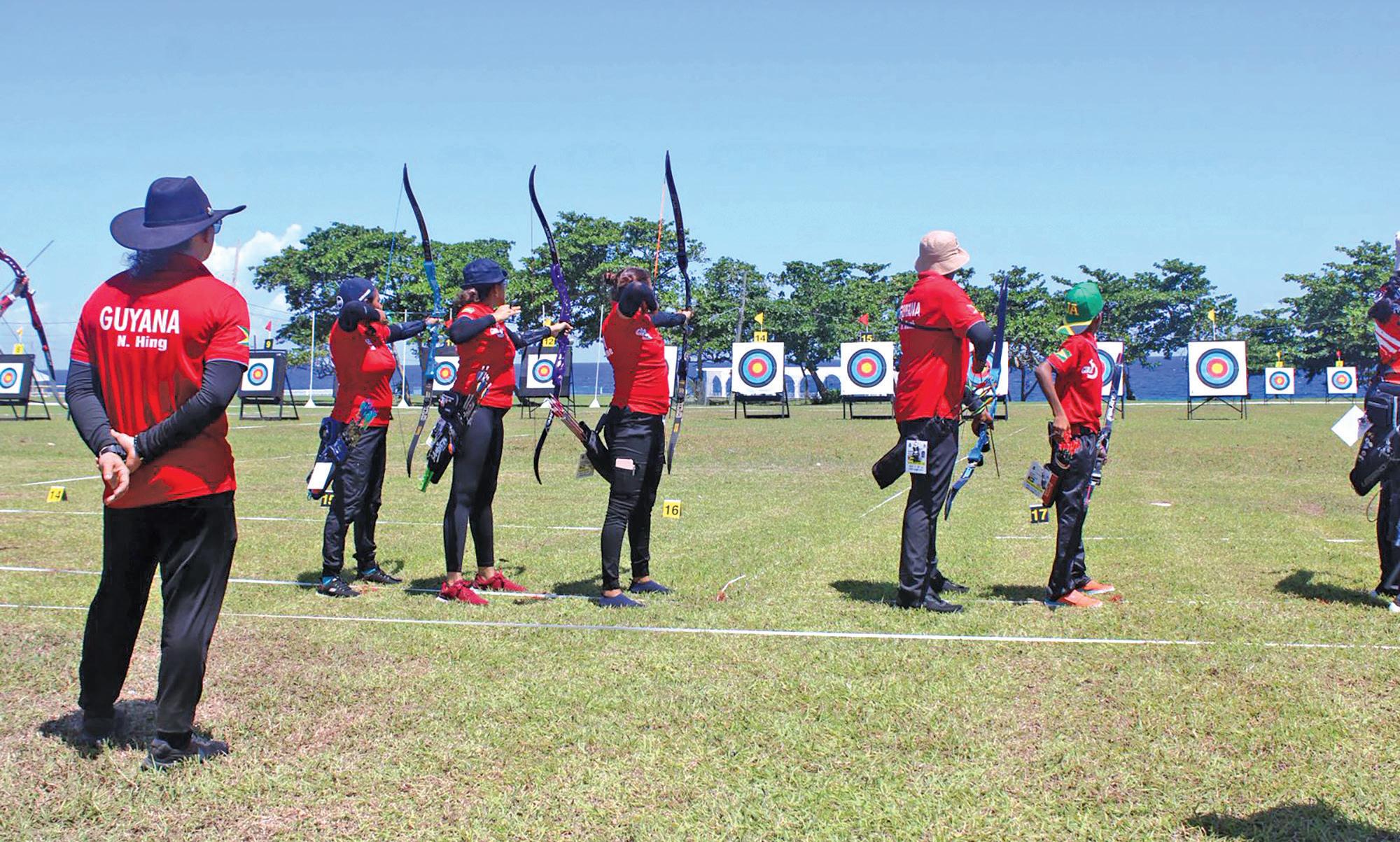
The Caribbean Development Archery League (CDAL) is a remote archery competition sanctioned by World Archery Americas, designed specifically for beginner archers from English-speaking Caribbean federations. Its aim is to promote growth and development in the sport, offering foundational competitive experience to new athletes in preparation for future international events like the Caribbean Development Championships (CDC).
The national federation, Archery Guyana is proud to report its outstanding results at the 2nd Annual CDAL, with 40 local archers participating from various clubs across Guyana, 10 advancing to the elimination rounds, and eight medals being earned across several categories and bow disciplines.
This year’s showing follows Guyana’s historic debut at the inaugural CDAL last year, where Jermaine
Kendall secured a silver medal, setting the tone for the country’s upward momentum in regional archery.
Archery Guyana
President Vidushi PersaudMcKinnon praised the athletes and the federation’s committed team, stating, “This competition has proven that Guyana is cultivating world-class potential in our new archers. We commend every participant for their discipline and drive, and we celebrate our medallists for their exceptional performances.”
She also extended heartfelt recognition to Sanjay Jiandani, President of the Archery Association of S. Vincent & the Grenadines, for his tireless efforts in conceptualising, organising, and driving the CDAL initiative:
“Mr Jiandani’s dedication has created a vital space for development and camaraderie among our regional archers. His work behind the scenes is deeply appreciated and has made all
the difference in delivering a well-executed and meaningful league.”
As a remote competition, the CDAL allows archers to compete from their home countries while adhering to World Archery rules, with performance monitored and judged in real time. The league’s structure enables young archers to grow steadily, developing both confidence and skill ahead of higher-level international tournaments.
Archery Guyana extended thanks to its dedicated coaches, judges, club officials, and supporters.








